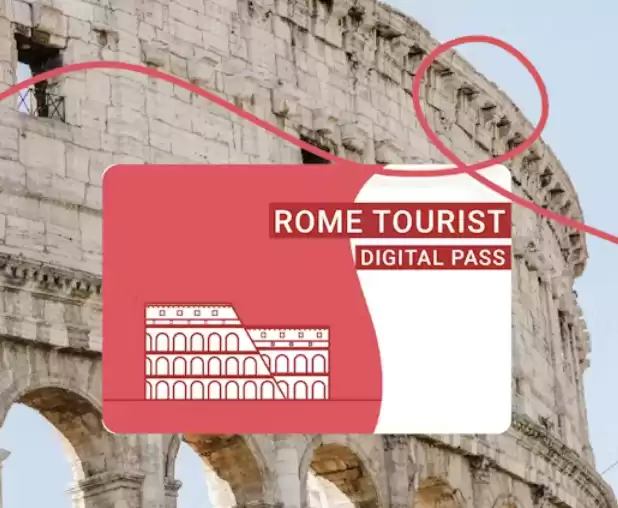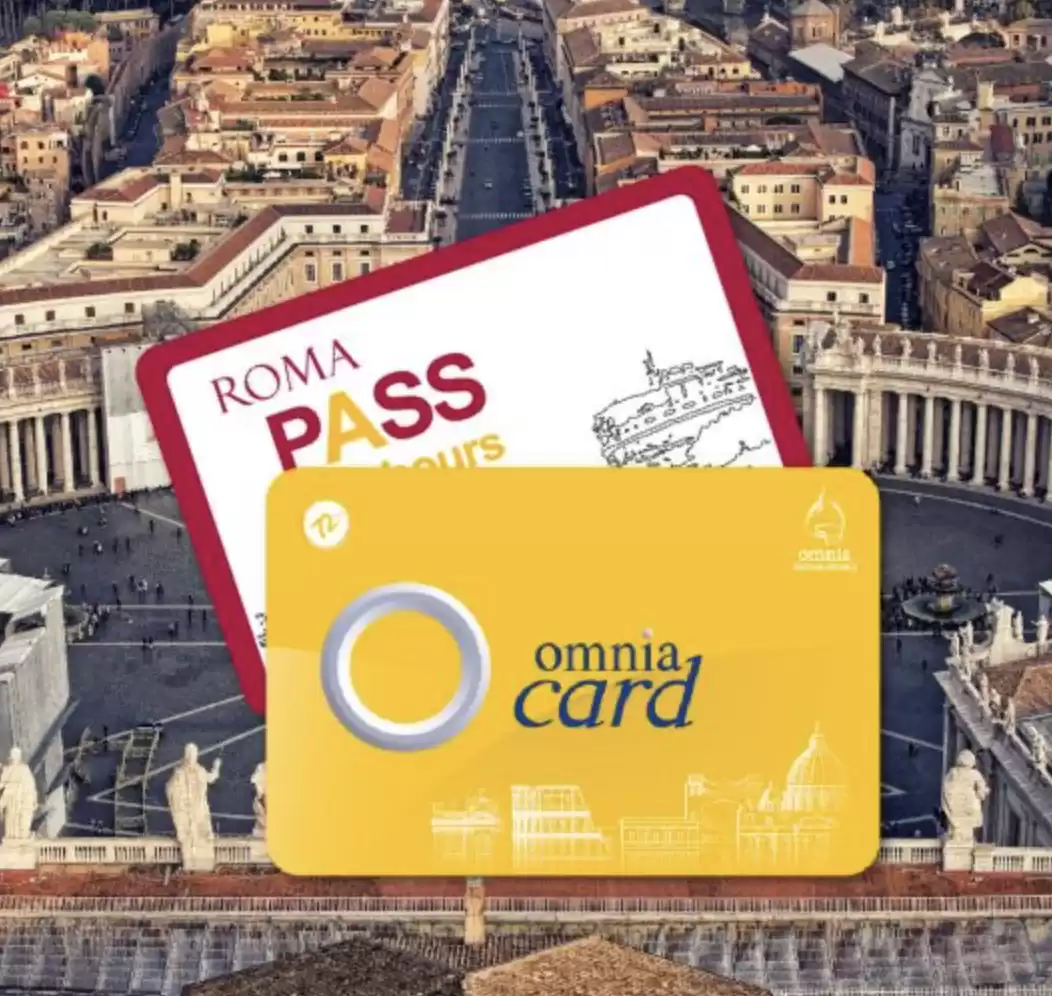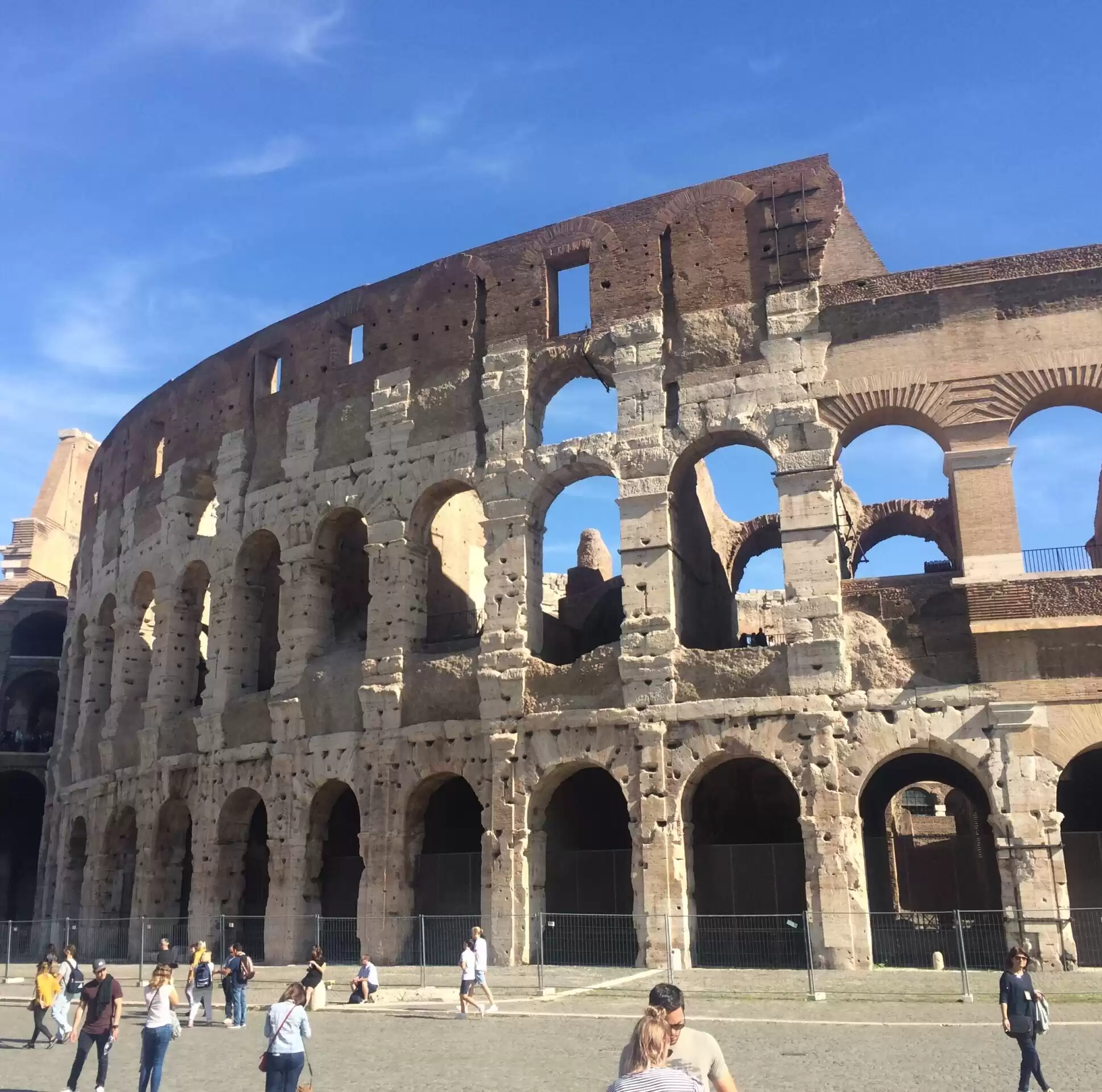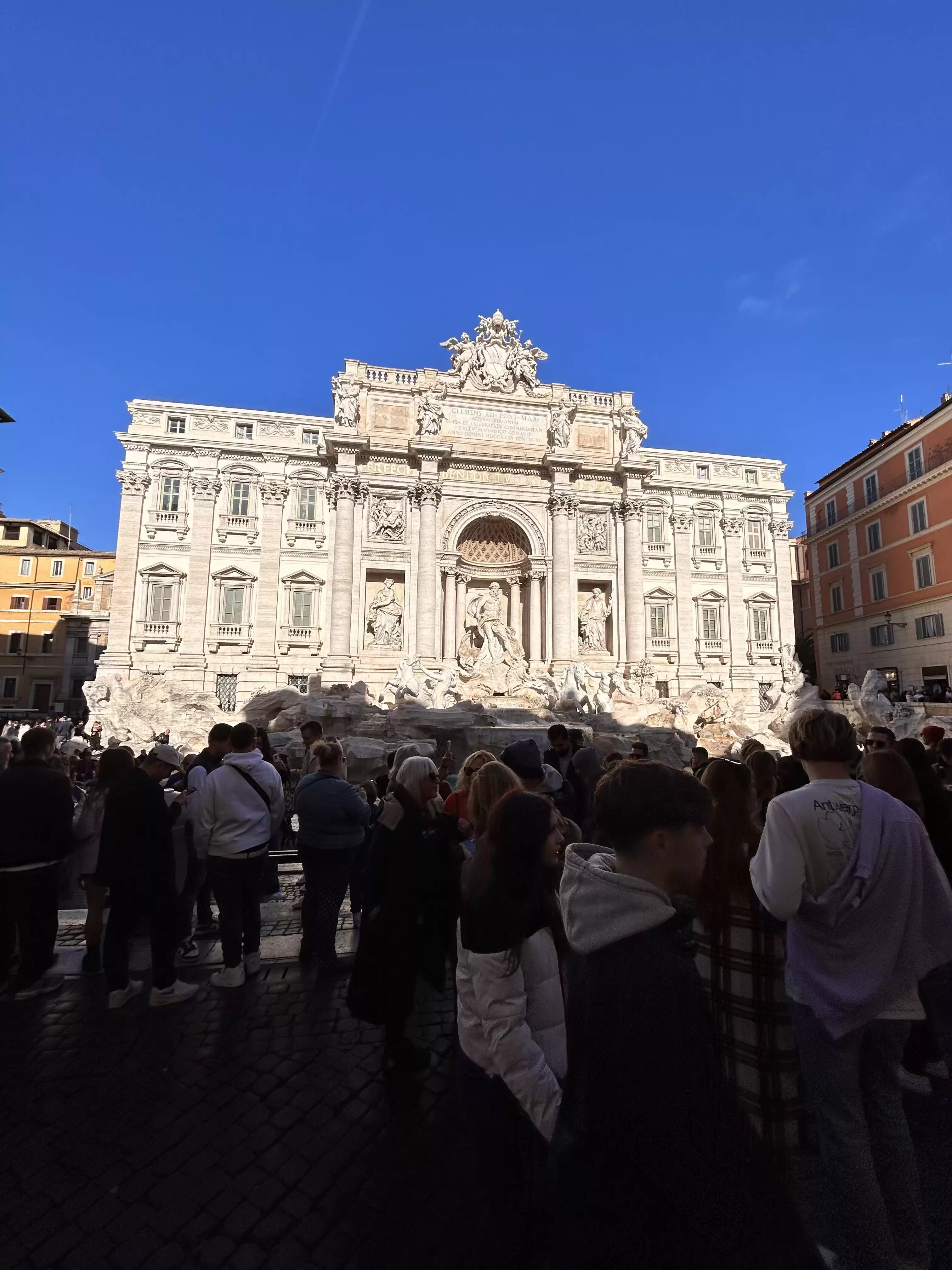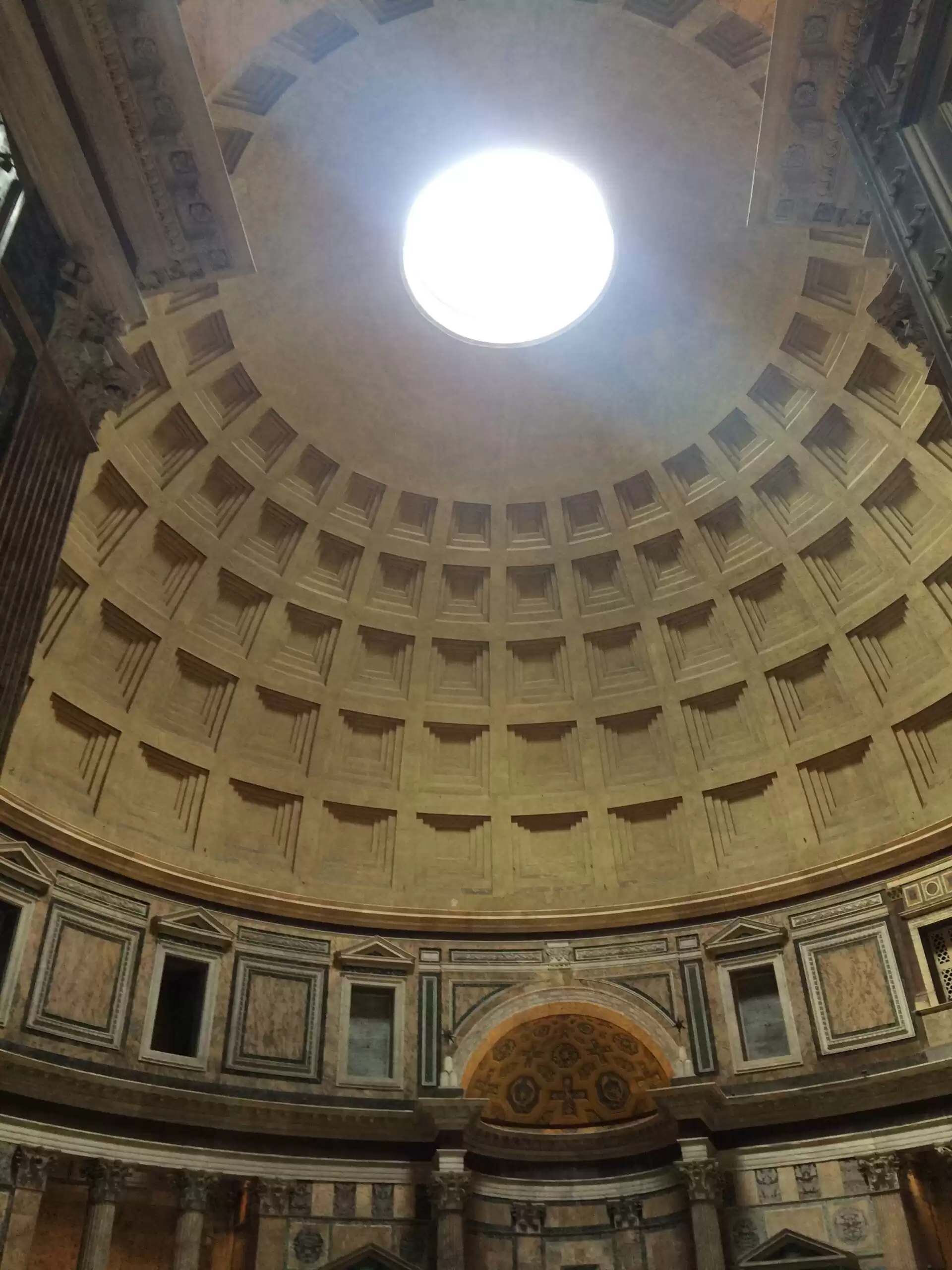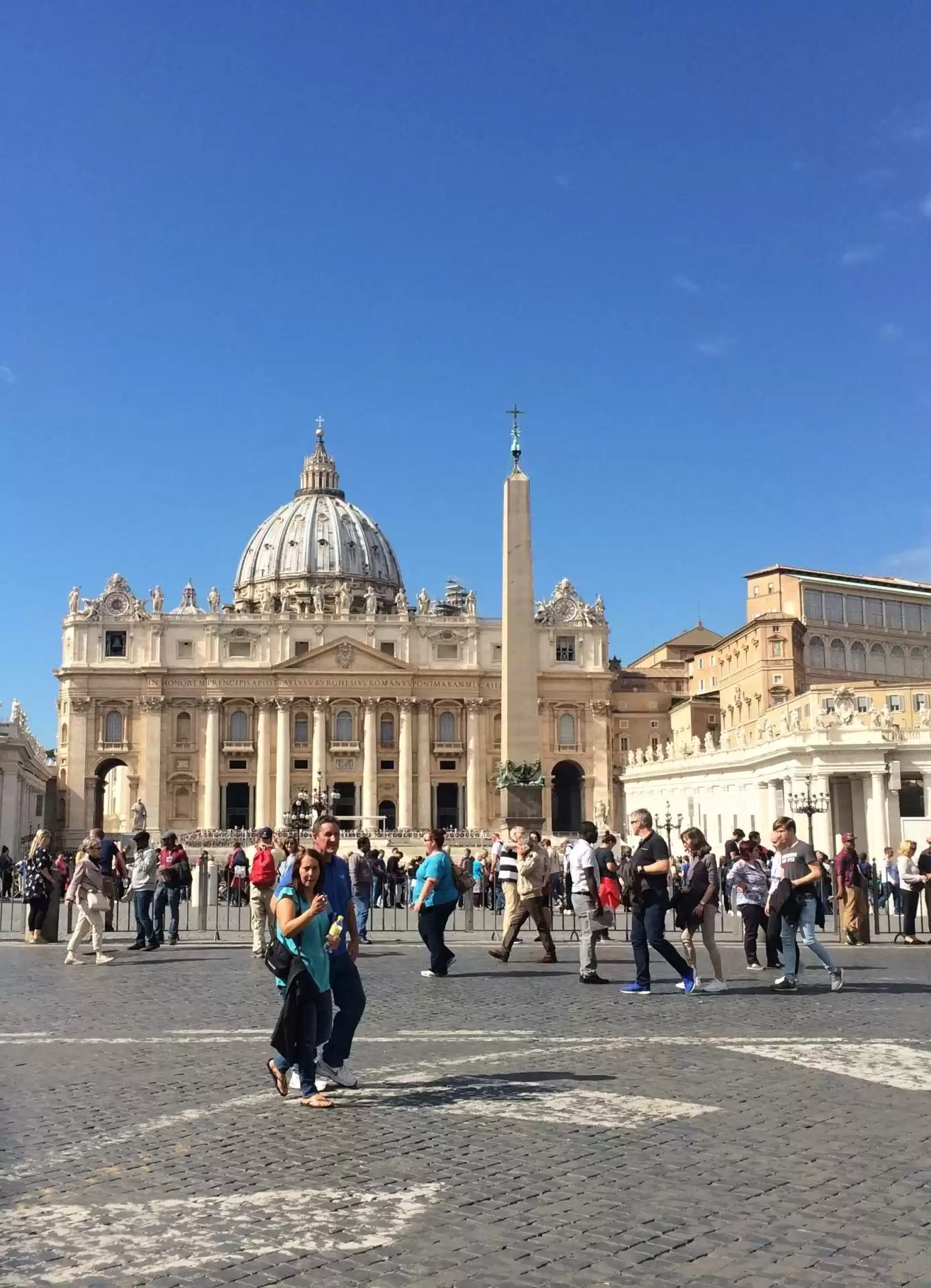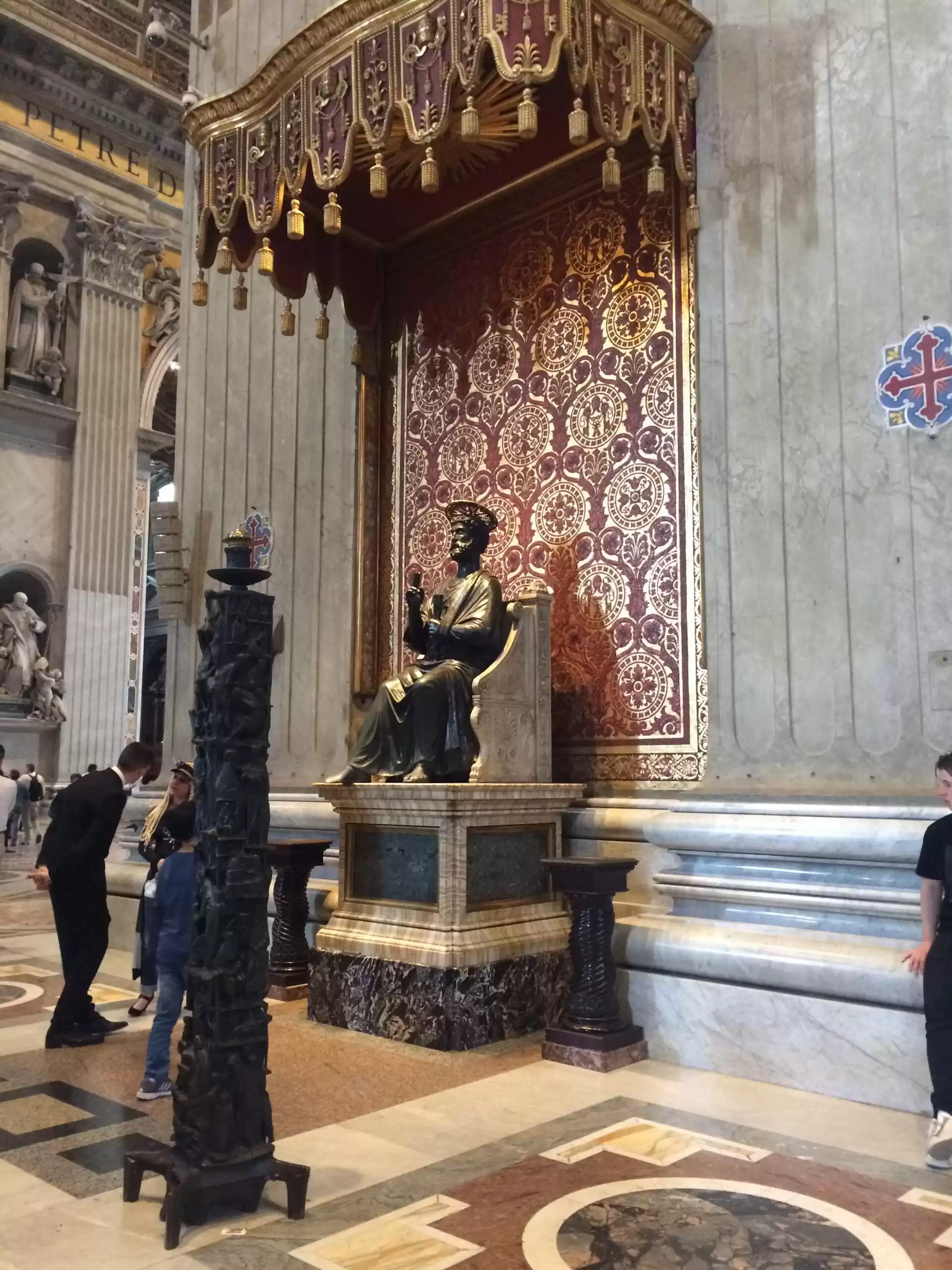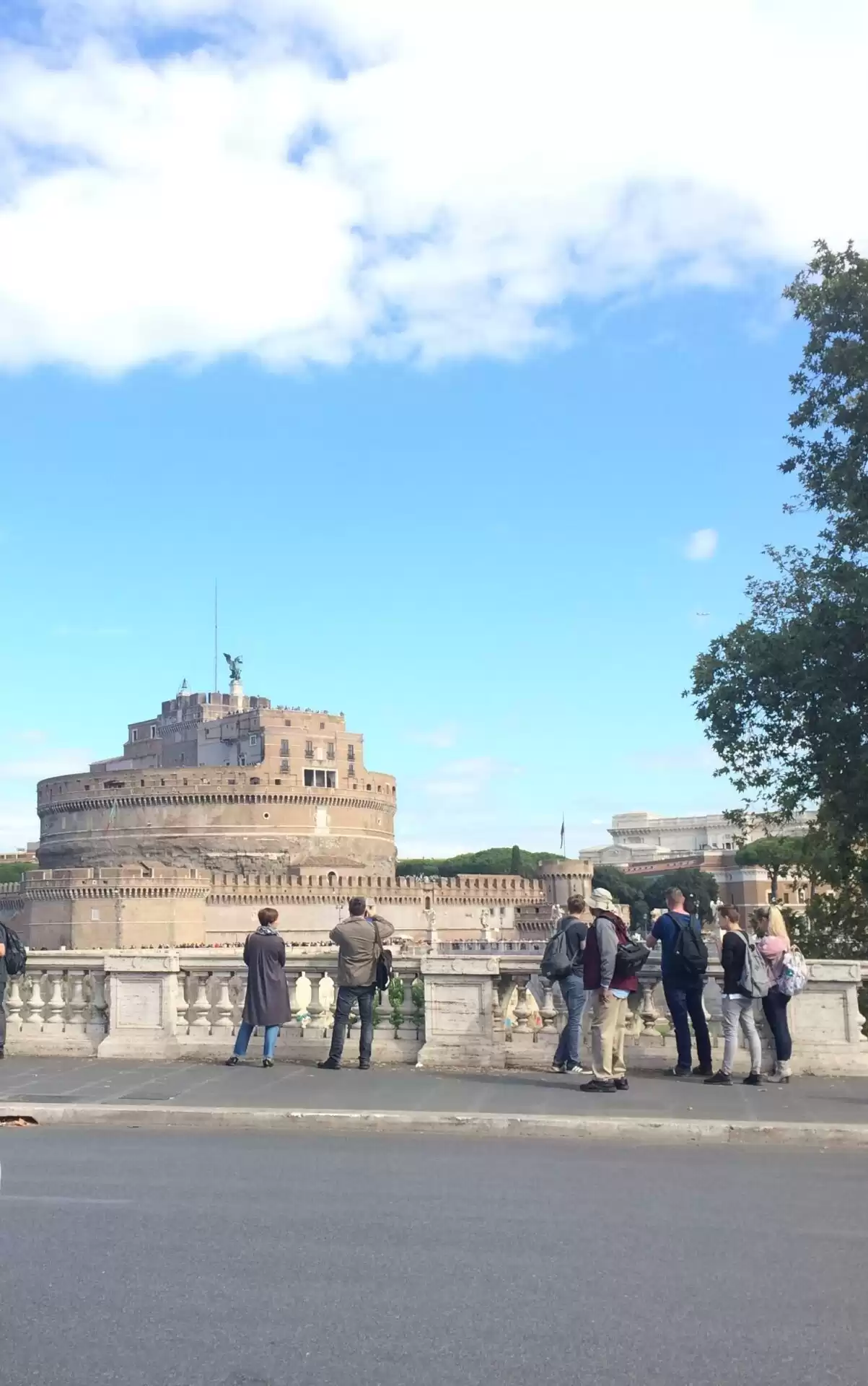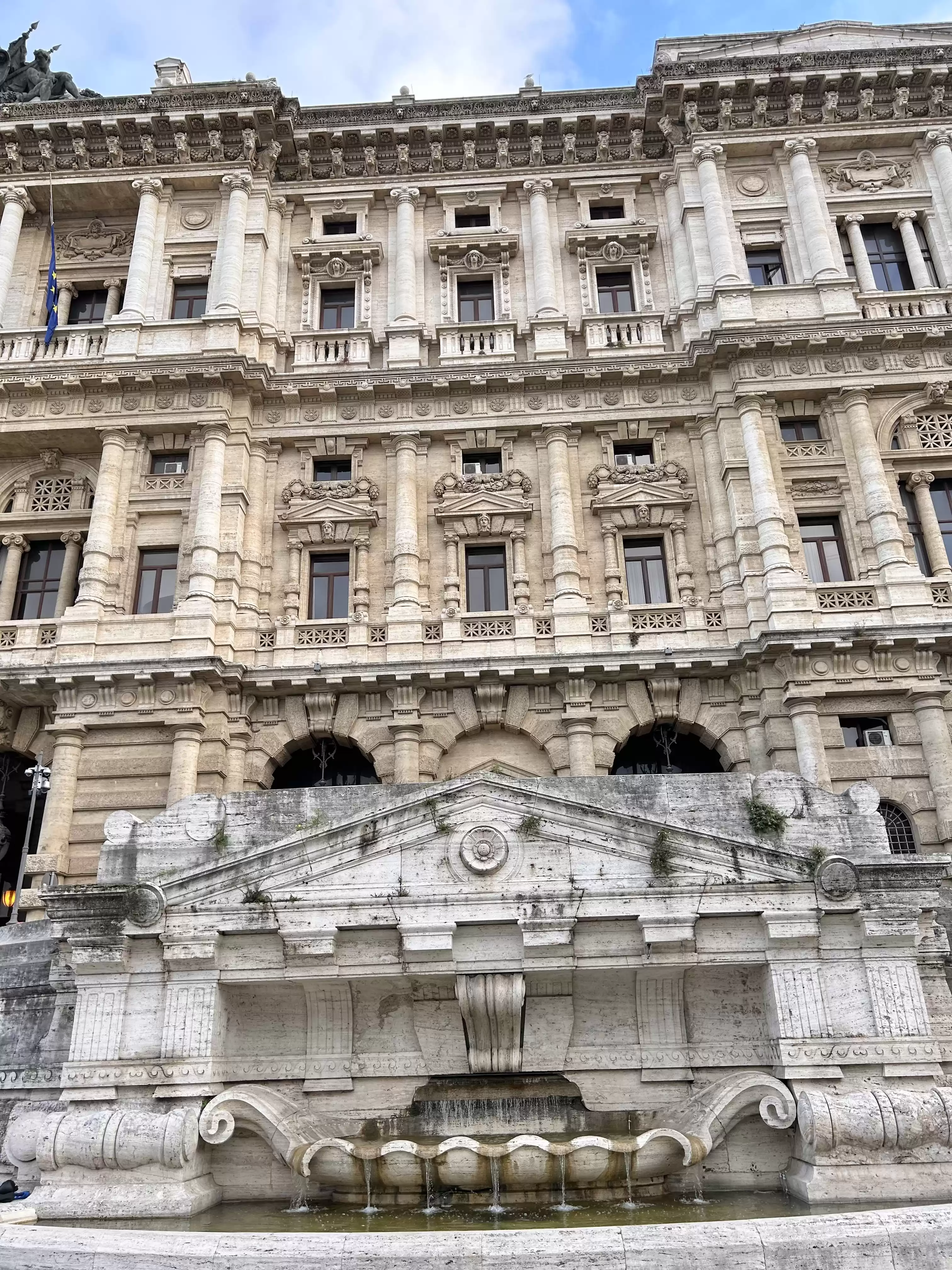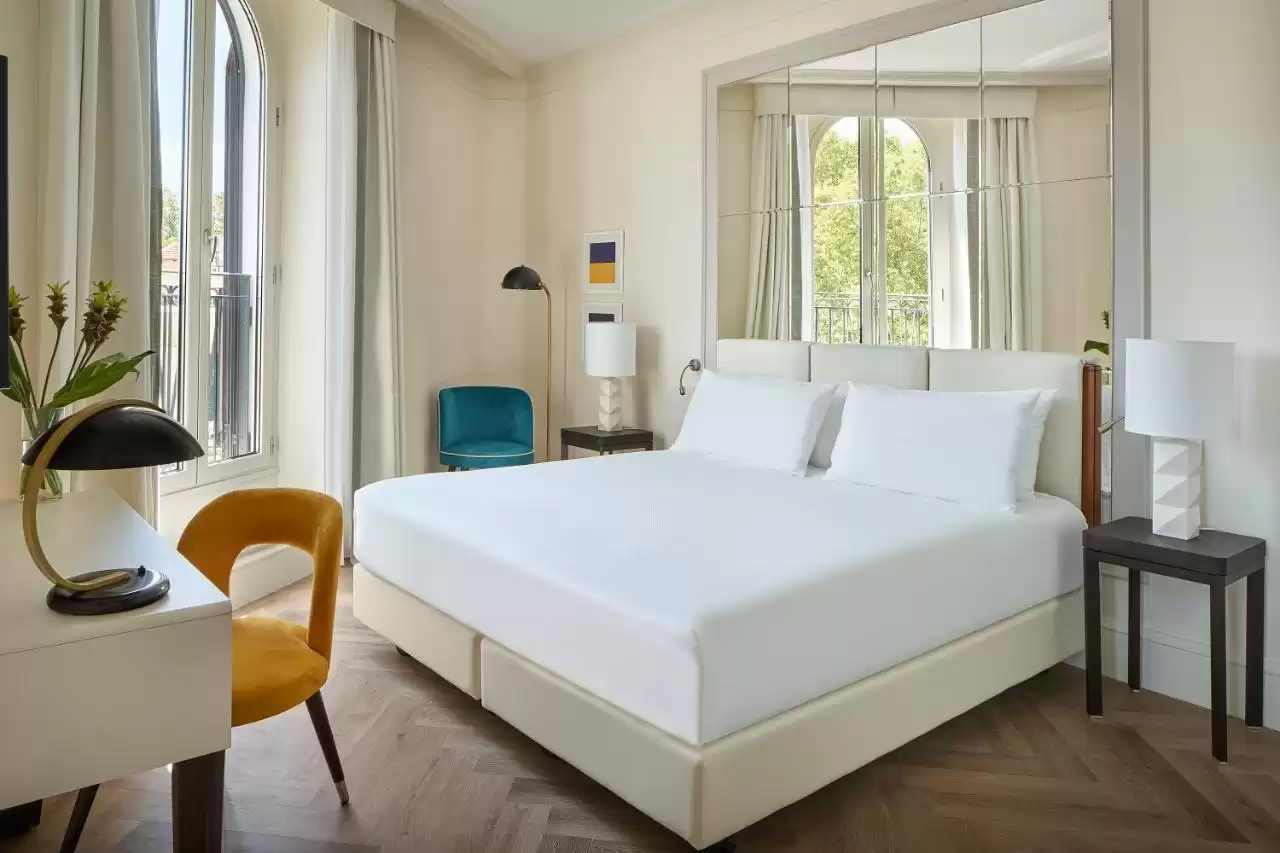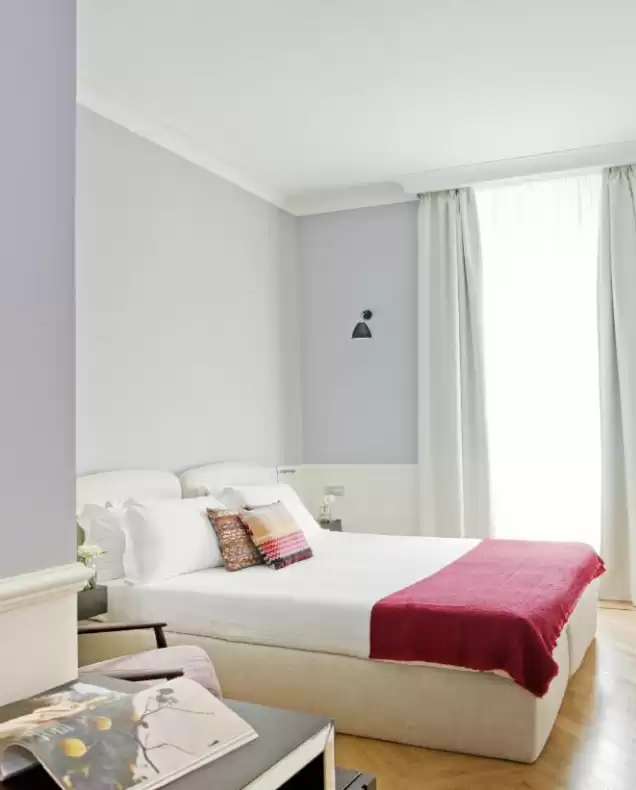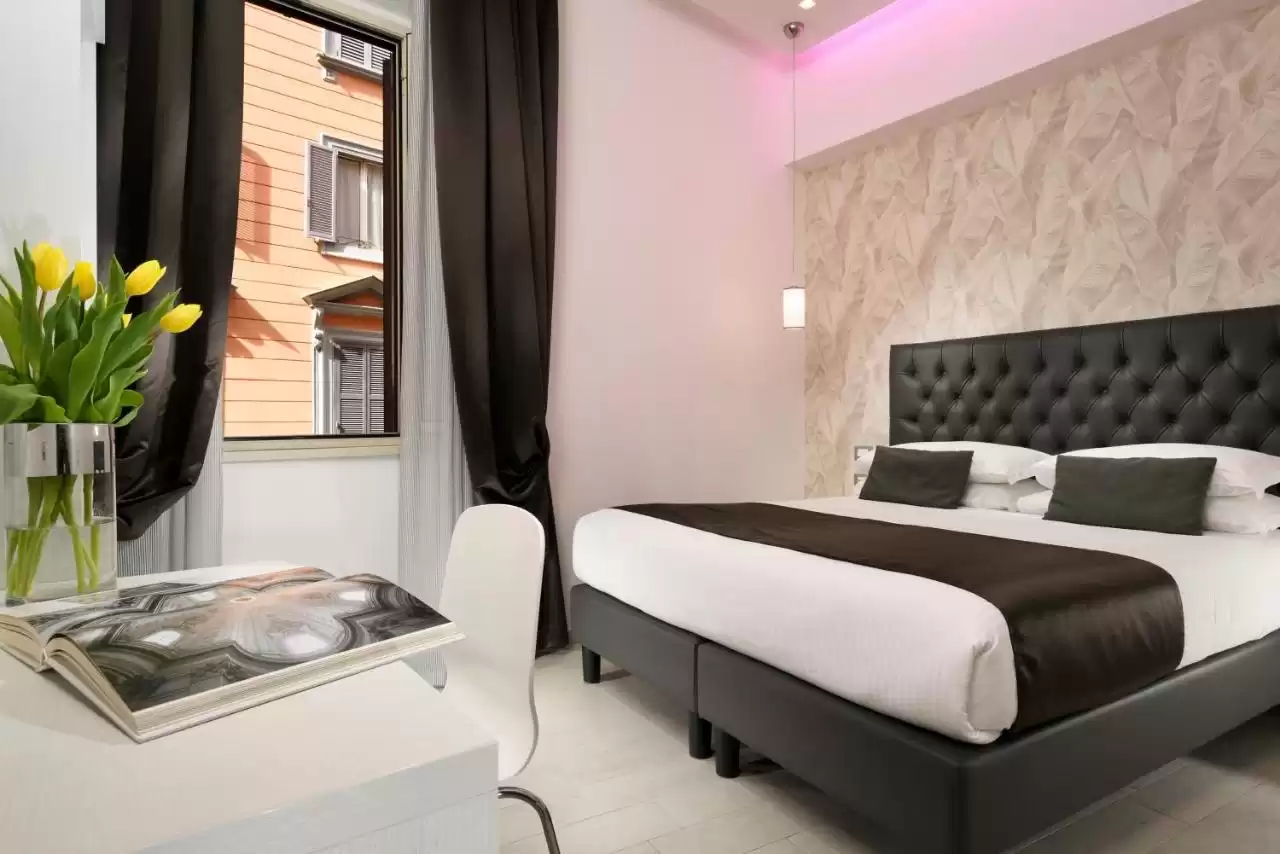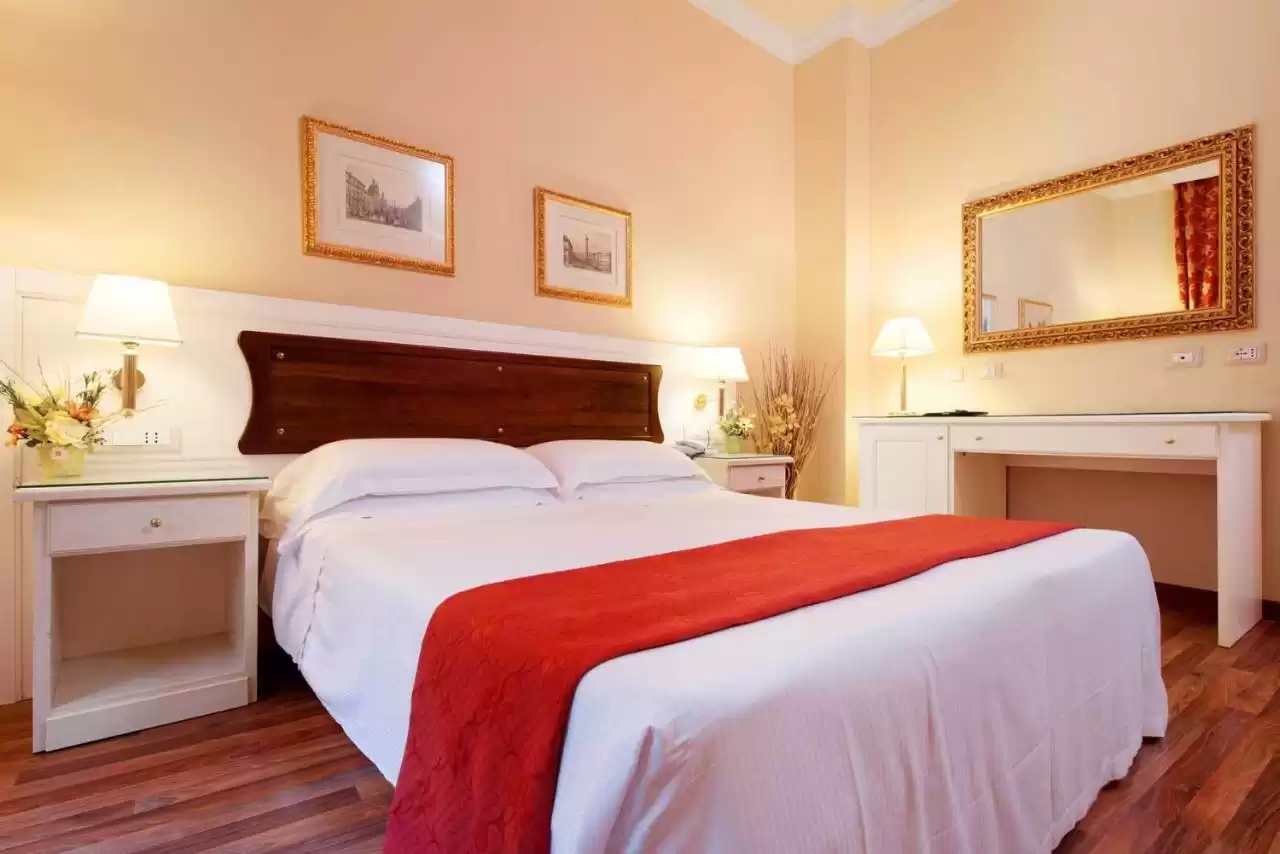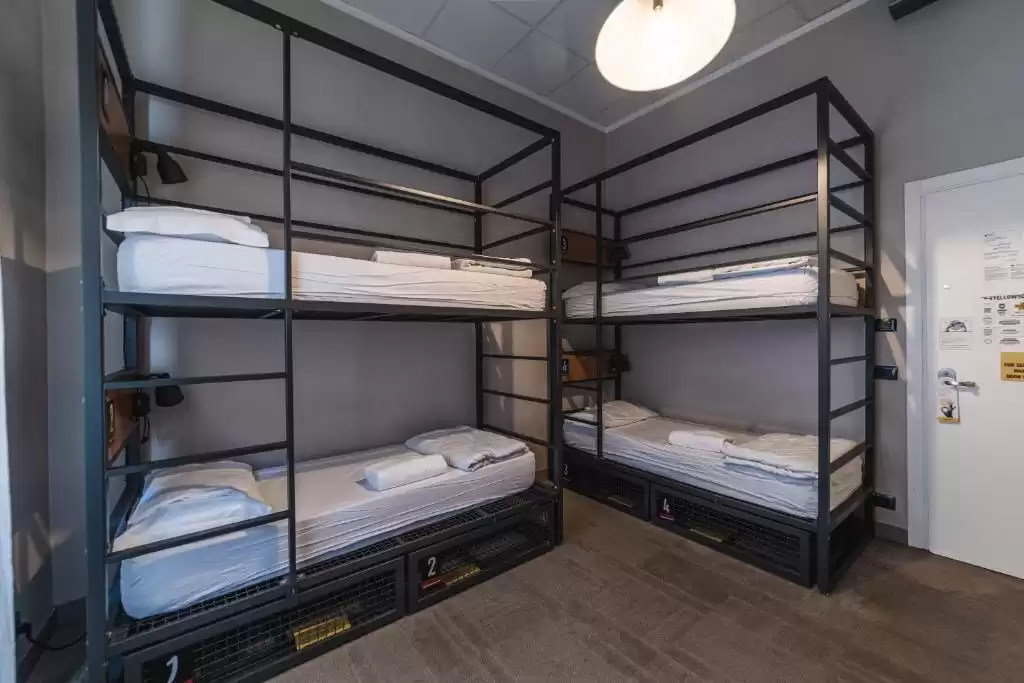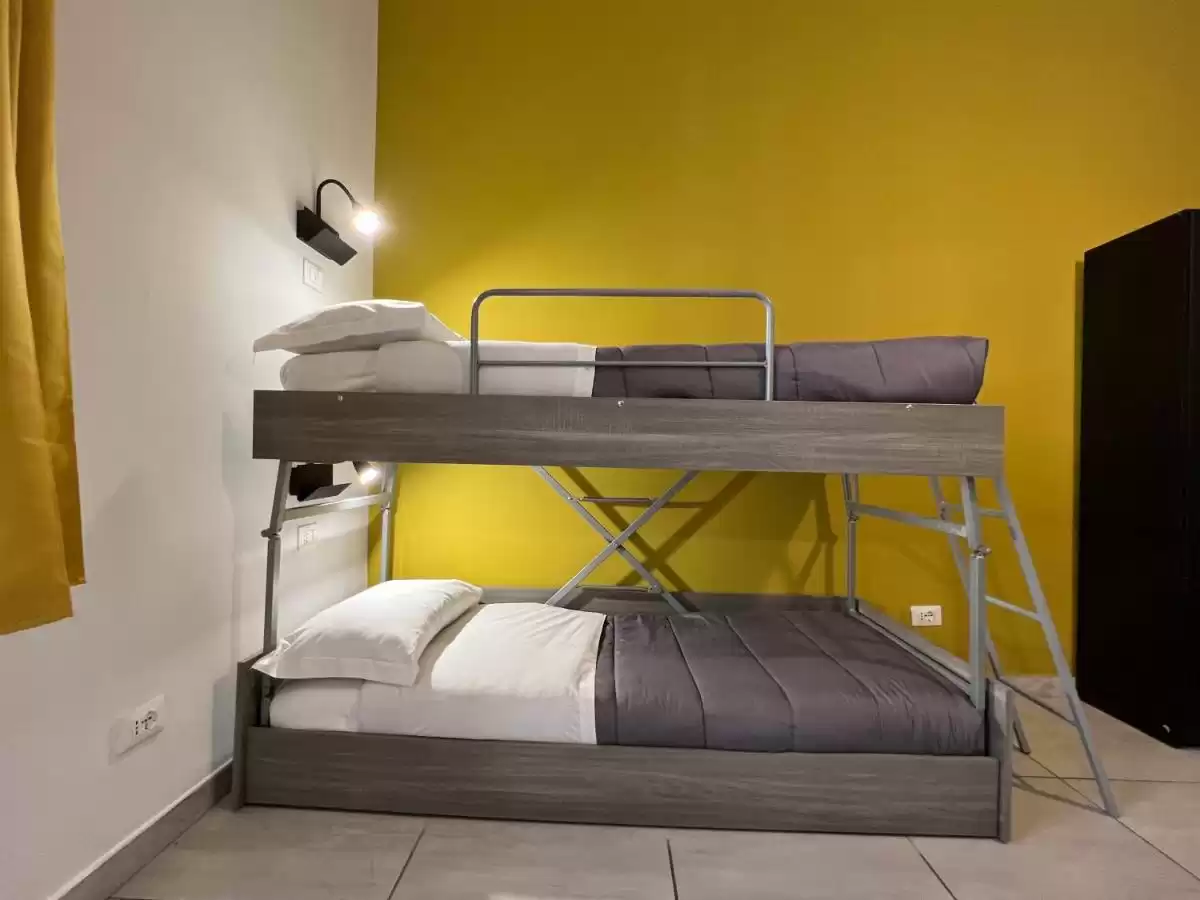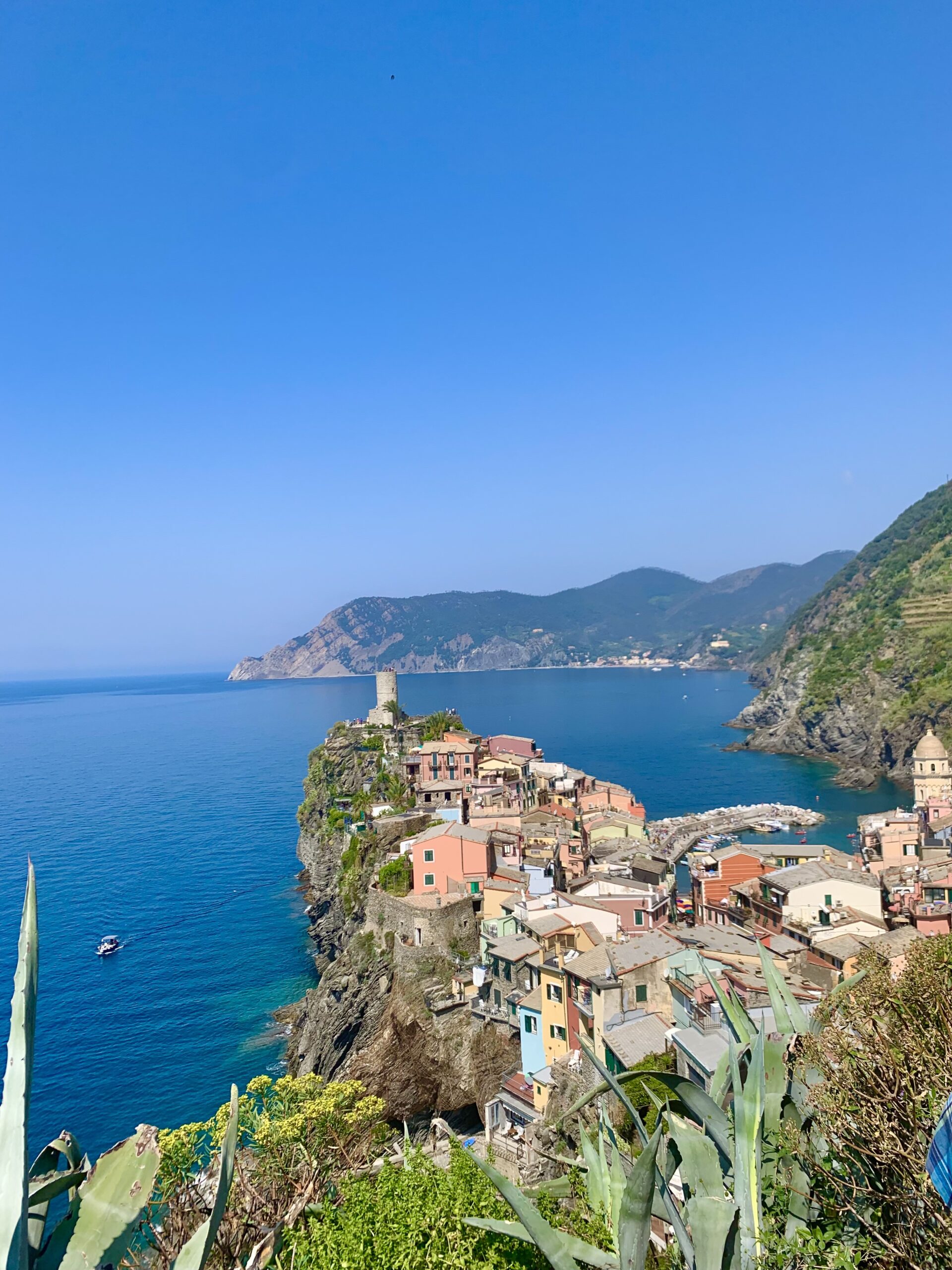Are you planning a trip to Rome?
Then you have come to the right place! Through this guide you’ll get all the best things to do in Rome, including hidden gems of the capital of Italy as well as how to get around, what to know before you go and where to stay.
Rome, the capital of the 301,230 km^2 country and host to some of the most famous landmarks in the world. Rome is a MUST in your Italy itinerary. Let’s dive into the allure of Rome and discover some of the must-see attractions that make this city an eternal favourite among travellers.
HOW TO GET TO ROME
Rome’s international airport, Fiumucino, is located approx 40-50min outside the city. To get to the city center, there is a high speed train that departs for Rome Termini train station (located downtown) every 30 minutes. Otherwise you can of course take a taxi or uber.
GOOD TO KNOW BEFORE YOU GO
To make your trip to Rome run a little more smoothly – please be aware of these bullet points
- Look up museum hours before planning your itinerary. Many museums are closed on Mondays in Rome, and some Churches have limited availability on Sundays. Plan accordingly.
- Siesta: Many Italian shops close from around 1-3pm everyday, as store owners head home to enjoy a lunch with family and a short nap. This is not as common in Rome but it’s still a good idea to check opening hours.
- Bring a scarf for churches: It’s required to have your shoulders covered in most churches. It’s a good idea to have a scarf on you just in case you need to throw it on.
- Wear comfortable shoes: This is a walking city and you will get blisters!
- Currency: Italy uses Euro (EUR).
- Credit Cards vs. cash: Cards are used all over Rome, especially Visa, but it’s more common to use cash for small items. So ALWAYS have coins on you!
ROME CITY PASS OPTIONS
If you’re overwhelmed by the many tickets you’ll have to keep track off – get yourself a City Pass! There’s many different ones that suit different needs. Below are my Top Picks:
Included in the city pass:
- Colosseum, Roman Forum & Palatine Hill entrance tickets + priority access.
- Skip-the-line entrance tickets to the Vatican Museums & Sistine Chapels.
- Guided tour of St. Peter's Basilica.
- City Guide App with offline navigation.
- Personal 10% discount code on any other site you want to visit.
You'll also get a downloadable audio guide that you can use at over 130 locations around Rome. Leave no stone unturned as you explore.
HOW TO GET AROUND IN ROME?
Rome is a walking city, and the best way to experience it is on foot! It is not advised to rent a car because the driving is…aggressive, and parking is restricted. The public subway in Rome is safe and convenient. They have two major subway lines that will take you almost anywhere in the city. If you intend to stay in the city for 72 hours, you may get a RomaPass for 38 euros, which gives you unlimited access to all public transportation.
WHEN IS THE BEST TIME TO VISIT ROME?
At all costs avoid visiting Rome (or Italy in general) during summer from june-august, as the crowds are insane. I’ve been to Rome 3 times, respectively in april, may and october which was all close to perfect. Not too hot or cold and not too cramped.
HOW LONG SHOULD YOU STAY IN ROME?
Rome wasn’t built in a day, and I don’t suggest trying to see it all in 1 day…or 2, or 3. Rome is a rather large city! You’ll end up sacrificing quality for quantity by cramming your itinerary. I recommend staying between four days to a week.
- 48 hours (or 72 hours) use of the public transportation (ATAC) in Rome (bus, tram, metro and some train lines)
- Access to one museum or archeologic site (ex. Colosseum, Borghese Gallery, Castel S. Angelo)
- The Roma Pass is activated on your first entry to the museums/sites or at the first journey on public transport
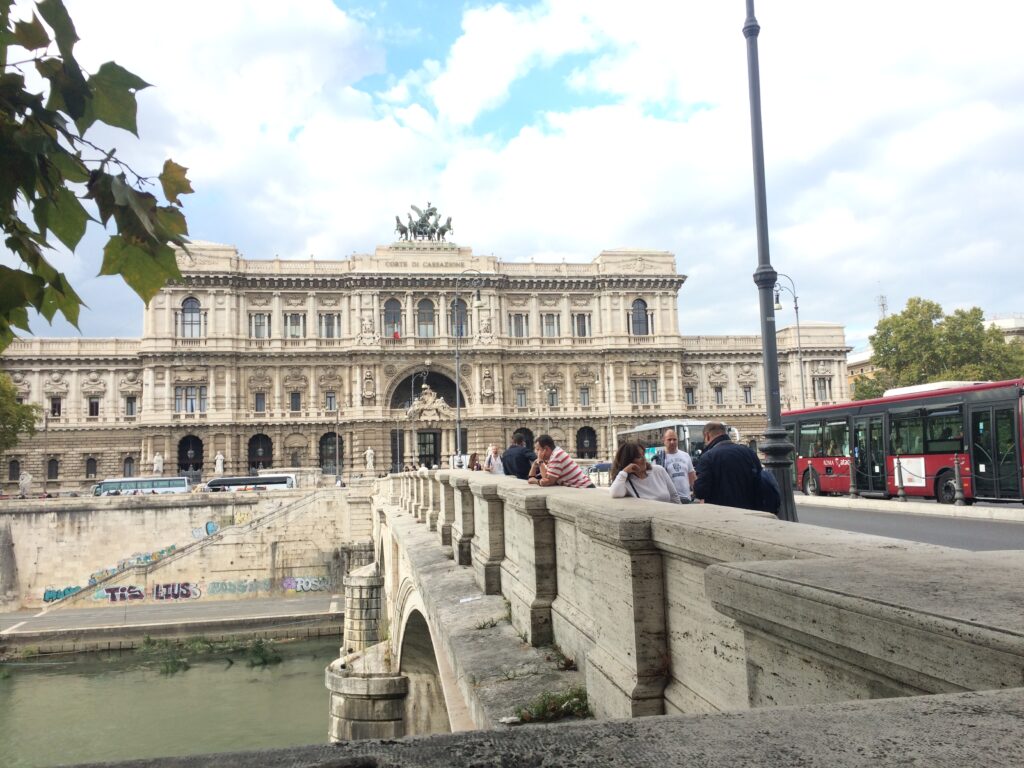
BEST THINGS TO DO IN ROME
Now let’s get to it! Here’s 25 of the best things to do in Rome👇🏼
1. THE COLOSSEUM
A glimpse into ancient roman glory
A visit to Rome wouldn’t be complete without exploring the iconic Colosseum, a majestic amphitheater that once hosted grand gladiator contests. Be sure to join a guided tour to get the full experience and learn about the fascinating history and engineering behind the Colosseum’s construction.
2. ROMAN FORUM AND PALATINE HILL
Walk amongst Ancient Ruins in present Rome
Right next to the Colosseum you can step back in time again, as you explore the Roman Forum and Palatine Hill. Palatine Hill is not technically a part of the Roman Forum but, from the perspective of a tourist, they are effectively the same. So how much time do you need to visit these landmarks? The simple answer is; it depends on your interest level. Most people recommend an hour for both sites. This might be a bit of an overkill if you have limited time in Rome. If you visit the Forum first, it is a much steeper climb from the direction up to the hill, so it is best to visit the Palatine Hill first and then descend to the Roman Forum.
Entry to the Roman Forum is no longer free, but it is covered by the single Colosseum ticket that grants access to the three sites.
Get up and close with one of the 7 wonders of the world. This legendary building and surrounding area is a must when visiting Italy.
FREE cancellation up to 24 hours before your booking.
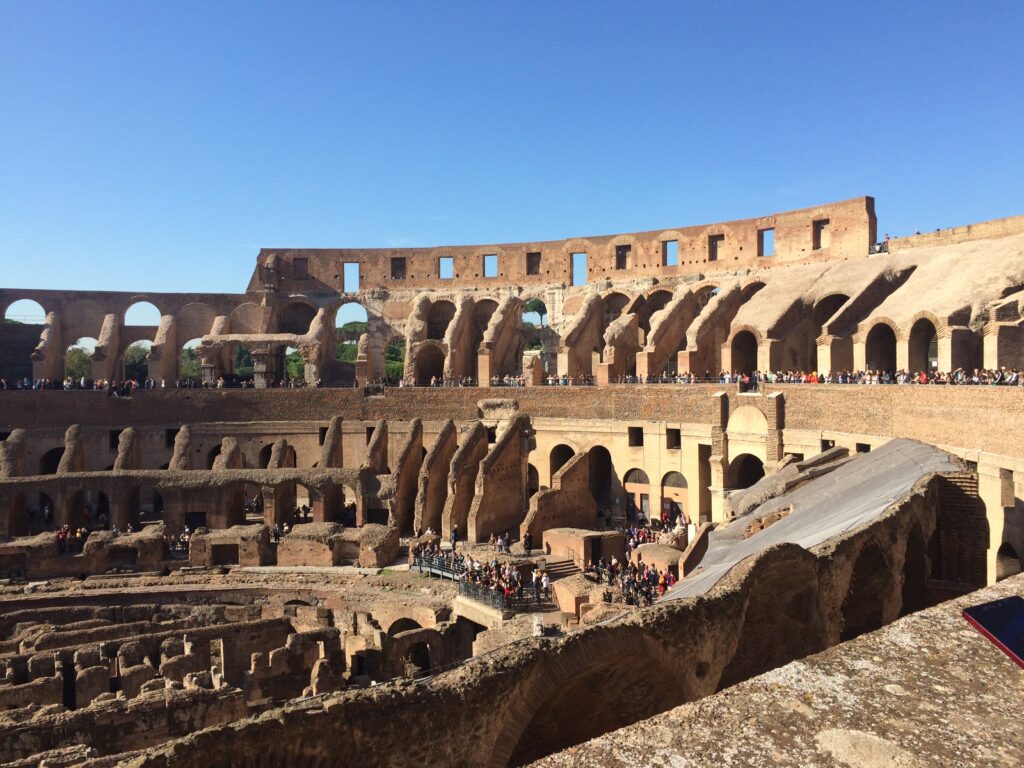
3. TREVI FOUNTAIN
Rome’s most beautiful fountain
Toss a coin into the stunning Trevi Fountain, and live out the myth of the fountain, that goes like this: If you throw one coin, you will return to Rome. If you throw two coins, you will fall in love with an attractive Italian. If you throw three coins, you will marry the person that you met.
Whether you believe the myths or not, the baroque masterpiece is a hub of wishes and dreams, as visitors from all corners of the globe seek a chance to experience this true masterpiece.
Pro Tip: Visit the Fountain as early as possible. It’s completely free and can be found at Piazza di Trevi district, specifically at the junction of three streets: Via delle Muratte, Via dei Crociferi and Via Poli.
Did you know, that you can go beneath the Trevi district and see the ancient building complex buried nine meters beneath the streets!
Warning: please be aware of scammers and pickpockets, as they are quite common in this area.
Did you know, that you can go beneath the Trevi district and see the ancient building complex buried nine meters beneath the streets!
For more info about pricing and opening hours
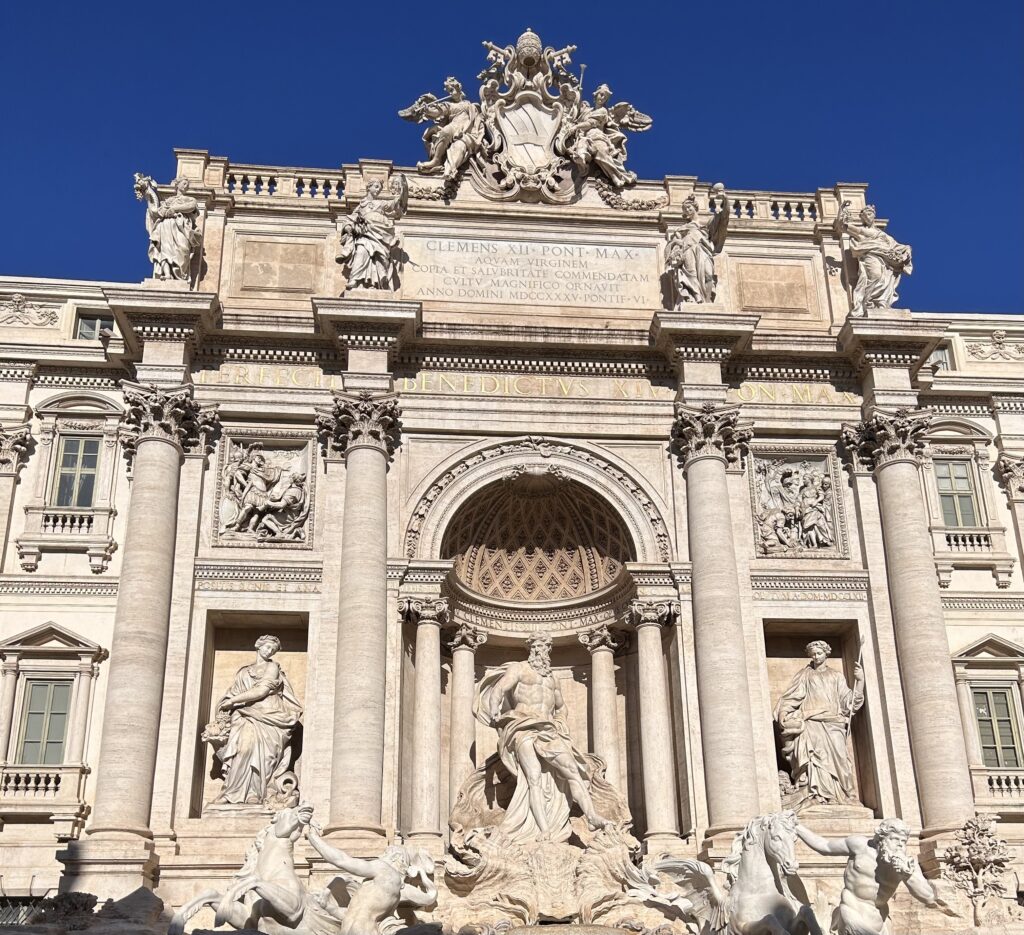
4. THE PANTHEON
A true testament to Roman engineering.
The most striking feature of the Pantheon is its dome, the largest unreinforced concrete dome in the world. It spans an impressive 43 meters in diameter and was a groundbreaking engineering feat at the time of its construction. The perfectly proportioned oculus at the top of the dome serves as the only source of natural light, casting mesmerizing rays that gracefully dance upon the marble floor below. The hole (Oculus) of 7.8 meters in diameter, is the only source of light and is the connection between the temple and the gods above. Rain occasionally falls through it, but it is slanted and drains the water when it hits the floor.
Entrance to The Pantheon is no longer free (from July 3rd 2023). Tickets cost €5.
Is it necessary to buy a ticket in advance to visit the Pantheon?
The short answer is, it depends on when you visit and how long you are in Rome.
Getting a ticket online saves you time queuing and ensures a more smooth visit. But no - not a complete necessity ;))
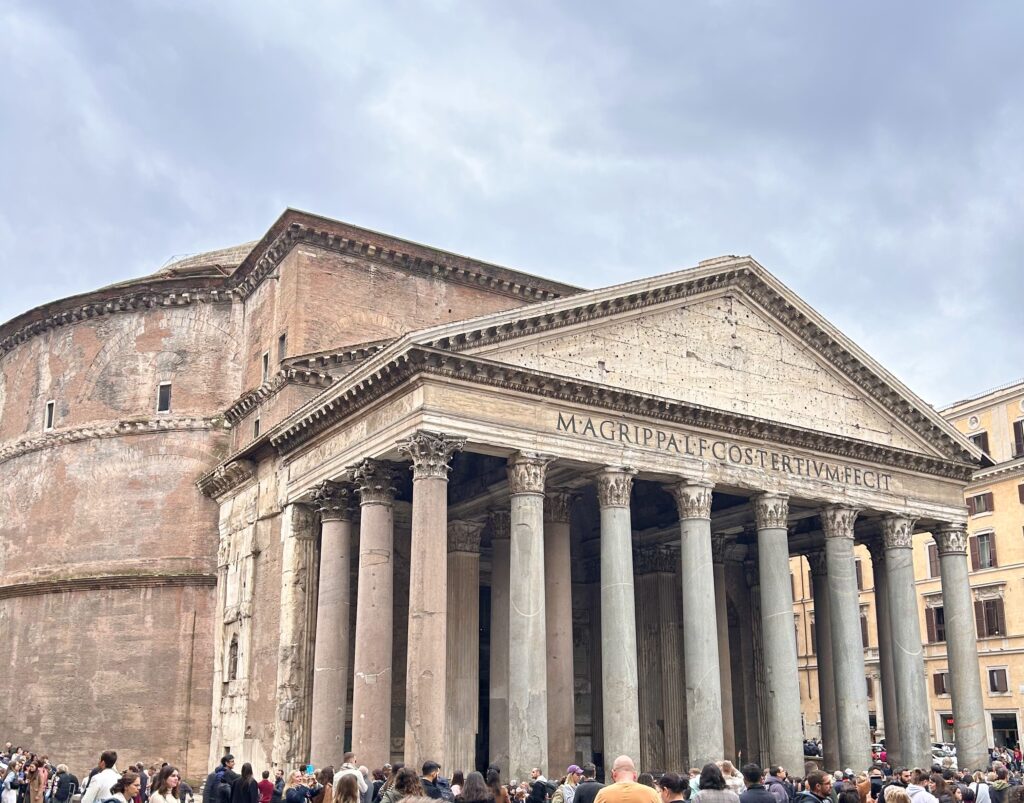
5. THE SPANISH STEPS OF ROME
A Romantic Icon in the heart of Rome
The monumental staircase consists of 135 steps that gracefully cascade down from the Trinità dei Monti Church at the top to the Piazza di Spagna below. The elegant curves and symmetrical design of the steps make them a true masterpiece of Baroque architecture.
Surrounding the Spanish Steps, you’ll find lots of high-end boutiques, designer shops, and stylish cafes, making the area a paradise for fashion enthusiasts and luxury shoppers.
PLEASE BEWARE that it’s an offence to sit on the Spanish step. Why? Read more about it here
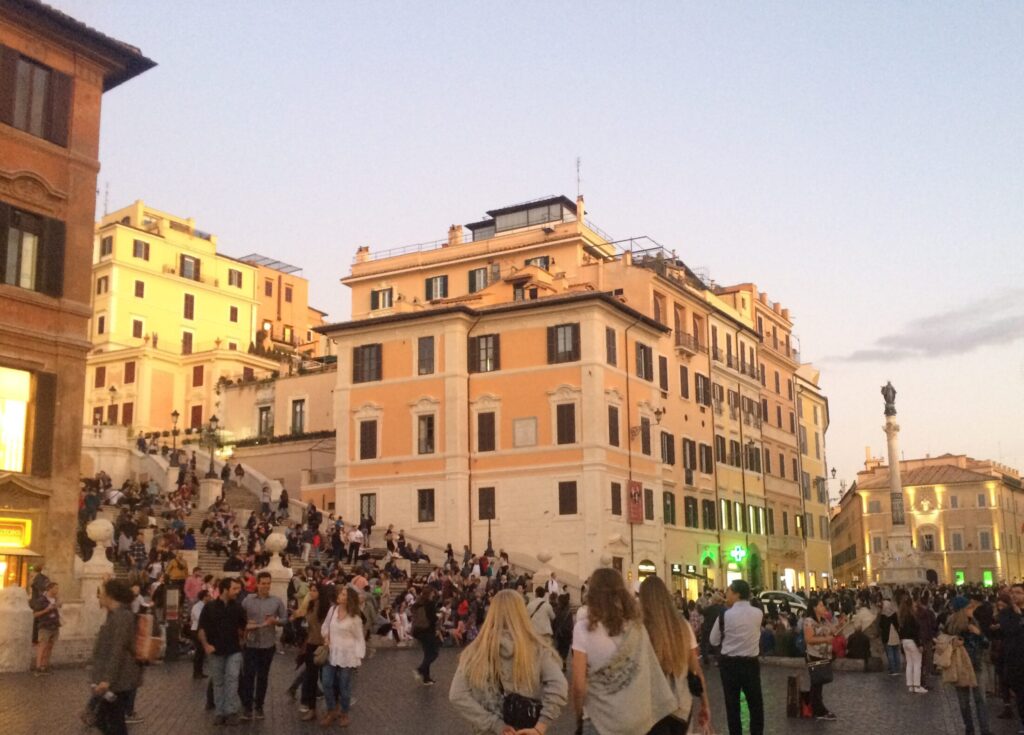
6. ST. PETER’S BASILICA – THE HEART OF ROME
An Architectural Marvel
he home of the catholic church and the largest church in the world is to be found at Vatican City in Rome. No less than five different architects worked on the design, of which Michelangelo is the best known.
There are more than 100 tombs in the St. Peter’s Basilica, of which 91 belong to former popes. If you want to see the relics of Saint Peter, you must access the crypt! (Anyone can visit the tomb through the Basilica, during its opening hours between 7am & 6.30 pm).
HOW MUCH DOES IT COST TO VISIT ST. PETER’S BASILICA?
Well, it’s FREE (if you are patient enough to wait for literal hours…)
It is also only the Basilica which is free – for example entering the dome cost €5.
If you have limited time in Rome I’d recommend you book a priority ticket for €19. If you also want a guide to show you around the huge monument it’s €27.
The best offer though is to combine a visit to all the Vatican Museums with a visit to St. Peter’s Basilica with a guide for €59.
- Climb the stairs to the top of St. Peter's Dome, 136 metres above the city
- Enjoy the panoramic views of Rome from the highest building in the city
- Admire the artwork of Michelangelo's Pietà and Bernini's Baldacchino
IS IT WORTH IT TO CLIMB THE DOME?
Absolutely!
One of the first things you notice when looking at St. Peter’s Basilica is its huge Dome with a height of 136 meters and an internal diameter of 42 meters. You can even climb the dome of St. Peter’s Basilica! It’s a long walk of 551 steps, but the reward is a spectacular panoramic view of Rome.
TIPS FOR VISITING ST. PETER’S BASILICA:
- Make sure you wear appropriate clothing. This includes covering your shoulders and knees. Tops that expose your chest or stomach are strictly forbidden.
- Don’t take pictures in the crypt
- You’ll have to pass security checks including metal detectors and x-ray scanners to get into either St. Peter’s Basilica or the Vatican Museums. So obviously don’t bring sharp objects etc.
- It is customary for pilgrims visiting the church to touch (or kiss) the bronze statue of Saint Peter’s feet. This tradition is so anient that millions of people must have touched the statue over the course of at least 800 years – that’s why Saint Peter’s foot seems strangely flat and thin. You don’t have to be religious to touch the foot, but you do have to be patient as – you guessed it – there’s lot of people.
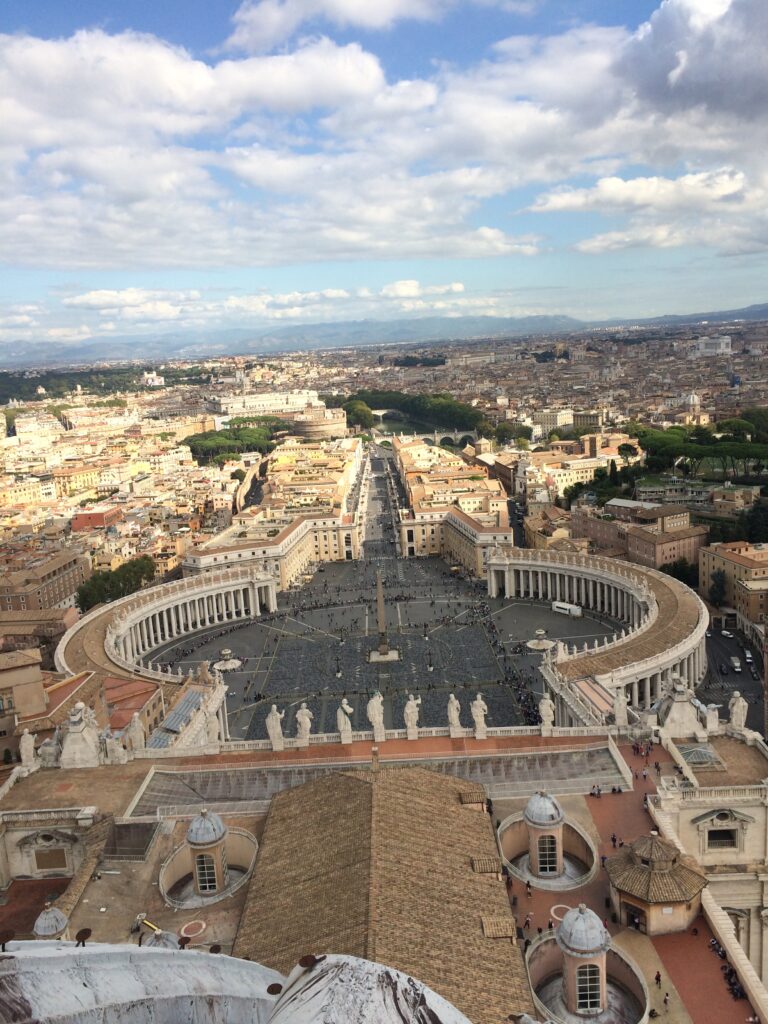
THE SISTINE CHAPEL
Originally known as the Cappella Magna (meaning the “Great Chapel”), the chapel takes its name from Pope Sixtus IV, and was built between 1473 and 1481. It is most famous for its Renaissance frescoes by Michelangelo.
Fun fact: Michelangelo hated working on the chapel. He had a lot of physical strain from painting the ceilings and even wrote poems about his pain.
The most famous painting
The central ceiling paintings show stories from the Book of Genesis—most famously “The Creation of Adam,”. This is probably one of the most popular paintings in the world, where figures representing God and Adam reach for each other with their arms and fingers outstretched.
To quote History.com “Some theorists think the scene also contains the unmistakable outline of a human brain, formed by the angels and robes surrounding God. According to Frank Lynn Meshberger, a doctor who pioneered this hypothesis, Michelangelo meant to evoke God’s bestowal of intelligence on the first human.”
Today the Chapel is used when the pope dies. Since 1878, the Sistine Chapel has been the seat of the Conclave, the assembly that elects the new Pope. The Conclave only takes place only in the event of the Pope’s death or renunciation for personal reasons. Besides that the Chapel is a part of the Vatican Museums.
Opening hours:
From Monday to Saturday: 9am – 6pm (Last entry at 4pm)
Every last Sunday of the month: 8am to 2pm (Last entry at 4pm)
Entrance fee:
Full price: €17 + €4 reservation fee
Reduced for students between 18 and 25: €8 + €4 reservation fee
REMEMBER: the Vatican Museums are closed on Sundays, with the exception of the last Sunday of the month, when they are open and free to visitors (if you visit before 12:30 pm)
Do you want to know more about the Vatican Museums? Read more here
THE BRAMANTE STAIRCASE
There’s two staircases in the Vatican Museums – the original stair, built in 1505, and a modern equivalent from 1932. The “Momo”, modern evolution of ‘Bramante’ spiral stairs of 1932.
It was built in a square tower and was designed to link the Belvedere Palace to the streets of Rome. It also allowed Pope Julius II to travel directly to his private residence by carriage. The reason this was possible is because the original staircase doesn’t have stairs but is more of a paved ramp. There’s two spirals which allowed traffic to travel up on one path and down on the other without colliding.
The original staircase is very difficult to visit and is limited for exclusive viewing only, but the modern Bramante’s Staircase is entirely open to the public. Also located in the Pio-Clementino Museum (also part of the Vatican Museums), this staircase marks the end of a museum visit, and is the route that all visitors take when leaving the building.
Due to the severe crowds and ridiculously long lines, it is nearly essential to pre-book your visit to the Vatican Museums.
Entrance price:
Adults: €16
Students (ages 19 – 26): €8
Pro tip: The best offer though is to combine a visit to all the Vatican Museums with a visit to St. Peter’s Basilica with a guide – check it out below.
Cancel up to 24 hours in advance for a full refund
- Tour guide
- Save on entrance fees
- Skip-the-ticket-line access to the Vatican Museums
- Skip-the-ticket-line access to the Sistine Chapel
7. CASTEL SANT’ ANGELO
Across the Bridge of Angels (one of the prettiest bridges in Rome), is the Mausoleum of Hadrian (a Mausoleum is “a stately or impressive building housing a tomb or group of tombs”). This one in particular is popularly known as Castel Sant’Angelo, or “Castle of the Holy Angel”, and was commissioned as a resting place for the Roman emperor Hadrian (76-138 CE) and his family. It was later utilised as a fort by the Popes and is now a well-known museum. Many people learned from the best-selling novel The Da Vinci Code that a “secret” route connects the castle to the Vatican. Pope Clement VII used this emergency exit twice, notably when Rome was attacked in 1527. While you’re here, don’t miss the spectacular views of the city from the Terrace of the Angel.
Pro tip: While you’re there, be sure to head to the nearby Ponte Umberto for a gorgeous view when you look back toward the Bridge of Angels and St. Peter’s Basilica.
- Spend more time exploring with skip-the-line entry privileges
- See Hadrian's tomb and the Papal corridors of Castel Sant'Angelo
- Marvel at sweeping views of the land from the terrace of the castle
8. WALK OR BIKE ALONG THE OLD ROME APPIAN WAY
Just outside the old city walls is the Appian Way, the most storied of all Roman roads. The Appian Way originally connected Rome to Capua near Naples, but eventually stretched 611 km from Rome to the town of Brindisi (the tip of the “heel” of Italy), allowing vital trade and commerce to connect the country during the Roman Republic, and you can still see ruts in the street from Roman chariots.
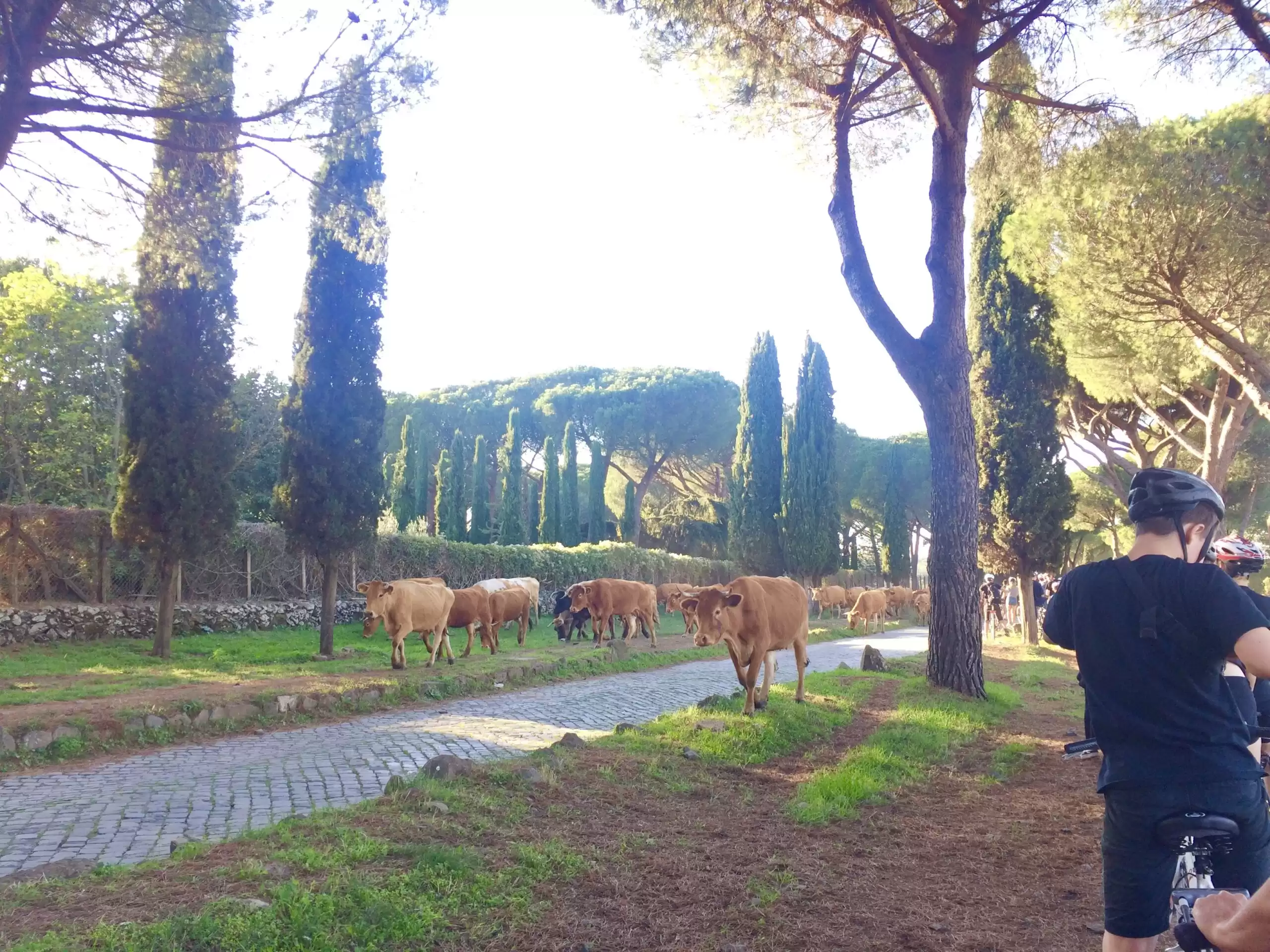 Via the Appian Way Electric Bike Tour
Via the Appian Way Electric Bike Tour
- Experience the aqueducts of ancient Rome
- Enjoy nature, history, culture and art on this tour
Duration: 4 hours
9. VISIT THE CAMPO DE’ FIORI MARKET IN ROME
Campo dei Fiori is probably the oldest market in Rome. This market square may be touristy, but it’s also beautiful, bustling, and worth stopping by. Every morning since 1869, the campo de’ Fiori market has transformed into a vibrant epicenter of the city. From fresh fruits and vegetables brought in from the Roman countryside to artisanal cheese and meat.
opening hours for the outdoor market are about 8 AM until about 2 PM Monday – Saturday (with some stalls open on sundays as well)
10. VISIT TO THE MOUTH OF TRUTH
Legend has it that liars who place their hand inside the marble sculpture would immediately lose it. Supposedly, Medieval Romans saw the sculpture as a lie detector for those who committed acts like adultery and perjury.
Now it can be found outside the doors of the Basilica di Santa Maria in Cosmedin, and to visit the sculpture you’ll have to pay a small entrance donation of €2 that also grants you access to the church and its crypt.
Fair warning, whether or not it’s worth visiting is a bit of a debate. You can try to stick your hand into the Mouth and see if you’re a liar, but that’s just for fun.
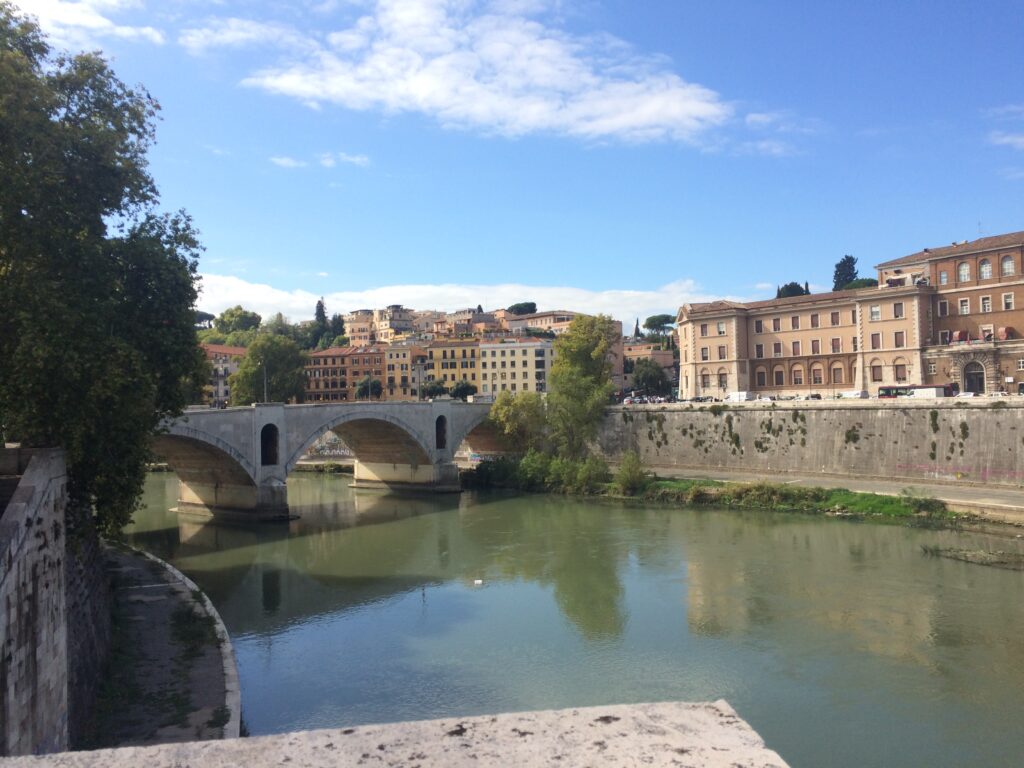
11. ALTAR OF THE FATHERLAND
On your way to the Piazza del Campidoglio the impressive Altar of the Fatherland. Despite the fact that the (massive) monument overlooks Piazza Venezia and most visitors to Rome pass it at least a few times when they’re near the Colosseum and Roman Forum, only a small percentage of visitors visit the top–and that’s a shame. You can climb to the 5th floor of the monument for free, however, it’s definitely worth the 10 Euro (cash only) fee to take the elevator all the way to the top when you’re seeking out the best views in Rome.
12. WALK AROUND THE COLORFUL TRASTEVERE NEIGHBOURHOOD OF ROME
Cross over the Tiber River to explore Trastevere, which means beyond the Tiber in Italian. one of Rome’s most picturesque and beloved neighbourhoods is also a very popular place for aperitivo, so if you’re looking for that iconic spritz on an outdoor table along a cobblestoned street vibe, Trastevere is the place to be.
Do you want a self guided walking tour of this amazing area? Find it here
JANICULUM TERRACE
Set above Trastevere, Janiculum Terrace boasts an incredible view of Rome, with most of its most famous monuments visible–but be warned, it’s a bit of a workout to get up there
Pro tip: this is the BEST sunset spot.
13. MONUMENTO A VITTORIO EMANUELE II
This monument was erected to honor Victor Emmanuel, the first unified ruler of Italy. It was cobbled together by eminent sculptors from all across the new nation and is located between Piazza Venezia and Capitoline Hill. It’s a stunning building you won’t miss as you’re walking the streets of Rome
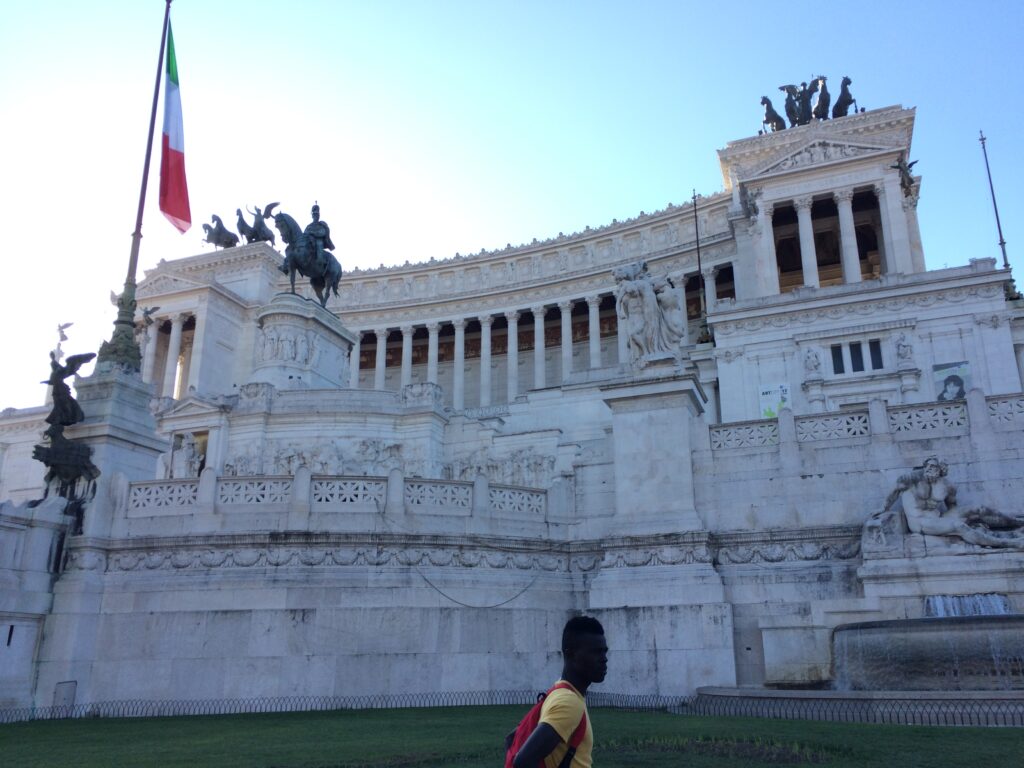
14. TOUR THE GALLERIA BORGHESE
A beautiful stroll from Pincio Terrace through the Borghese Gardens will lead you right to the Galleria Borghese and arguably one of the most impressive–though not one of the largest–art collections in Italy! If you have your heart set on visiting the Galleria Borghese, be sure to get tickets ahead of time!
Info about the Museum:
For security reasons, medium and large bags, shoppers, backpacks and baggages cannot be brought into the museum. Only small fanny packs and purses no larger than 21 x 15 cm are allowed to enter.
Getting into the museum is quite special as visitors can only go in every hour and each visit is timed to last a maximum of two hours. 180 people can enter each shift. This means that if you buy a ticket for 9am you have to be out by 11am, and that there at all times is max. 360 people in the museum at once (except from 9am to 10am when there’s only 180)
Entrance price:
FULL PRICE € 13,00 (last slot € 8,00)
DISCOUNTED 18-25 years of age € 2,00
FREE OF CHARGE under 18 years of age
RESERVATIONS to the museum are OBLIGATORY and it is necessary to pay a reservation fee of €2 when booking to visit.
The Galleria Borghese is part of the Roma Pass 72 hours and Roma Pass 48 hours. Obligatory reservation by phoning +39 06 32810, active from Monday to Friday 9:30 a.m. – 6 p.m. ,or writing to romapass@tosc.it
You will still need to show it at the ticket office for validation.
Opening hours:
The Gallery is open from Tuesday to Sunday. From 9 a.m. to 7 p.m. Last entrance at 5.45 p.m.
Need to know more? Find out here
Psst pro tip: if the Borghese gardens gets too busy, go to the lesser-visited Villa Doria Pamphili on the east side of the River Tiber, which is the perfect alternative.
- Explore the Gallery at your own pace
- See Caravaggio, Bernini, and Canova's most important paintings and sculptures
- Spend more time exploring the Borgehese Gallery by skipping the long entry line
Pro tip: choose the 9am entry
HIDDEN GEMS OF ROME:
15. THE AVENTINE KEYHOLE
Almost every tourist visits the Vatican to take photos, but much fewer visit the Aventine Keyhole to take an Instagram-worthy picture of St. Peter’s Basilica. Start at the Clivo dei Publicii, left of the Circus Maximus. Follow the road, which leads into Via di Santa Sabina. Keep walking! You’ll land at Piazza dei Calvieri di Malta: the location of the keyhole!

16. GALLERIA SCIARRA
A 5-minute walk from the Trevi Fountain and yet almost never crowded, the Galleria Sciarra is an excellent way to escape the crowds. The frescoes here have a specific theme: women, or even more specifically, female virtues. It’s a very small and short visit, as the building itself is used for offices today, so you can only see the small courtyard open to visitors during standard business hours.
The paintings are meant to depict female virtues, including Justice, Patience, Fidelity, and Strength.
From the outside, the building which hosts the frescoes looks rather normal, as a backdrop behind a McDonald’s.
17. TEATRO MARCELLO
Located in the Jewish Ghetto Area in Rome, this amphitheatre, also known as the Jewish Colosseum, looks a bit like a smaller Colosseum. The Theater was then named after Marcus Marcellus, Augustus’s nephew
The monument can’t be visited inside but it can be viewed from the outside at all times.
Want to know more? Get all info here
18. PYRAMID OF CAIUS CESTIUS
Pyramids aren’t the first thing that comes to mind when we think of Rome, but this pyramid was built as a mausoleum, in the middle of the reign of Augustus for the priest Gaius Cestius. He is best known for his tomb, which was unusual in Rome at the time, but little else is known about him other than that. It’s best to admire the tomb from the outside but you can go into the pyramid on the third and fourth Saturdays and Sundays of each month at 11am. Tours are only in Italian and tickets cost €5.50.
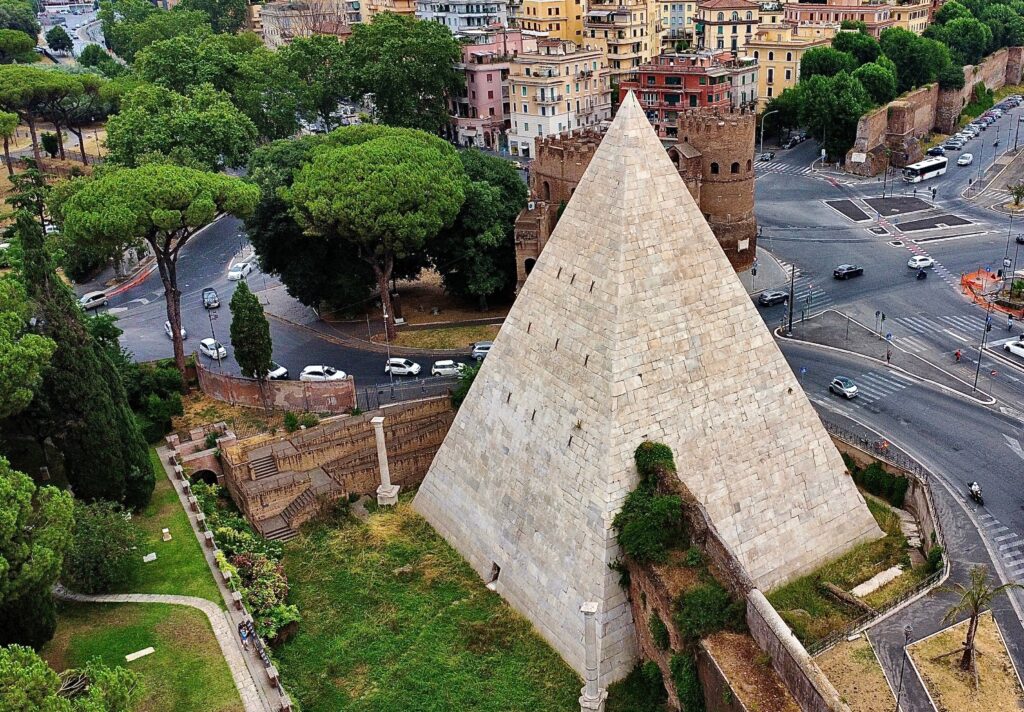
Credit: clemMT / Adobe Stock

Credit: Nicola / Adobe Stock
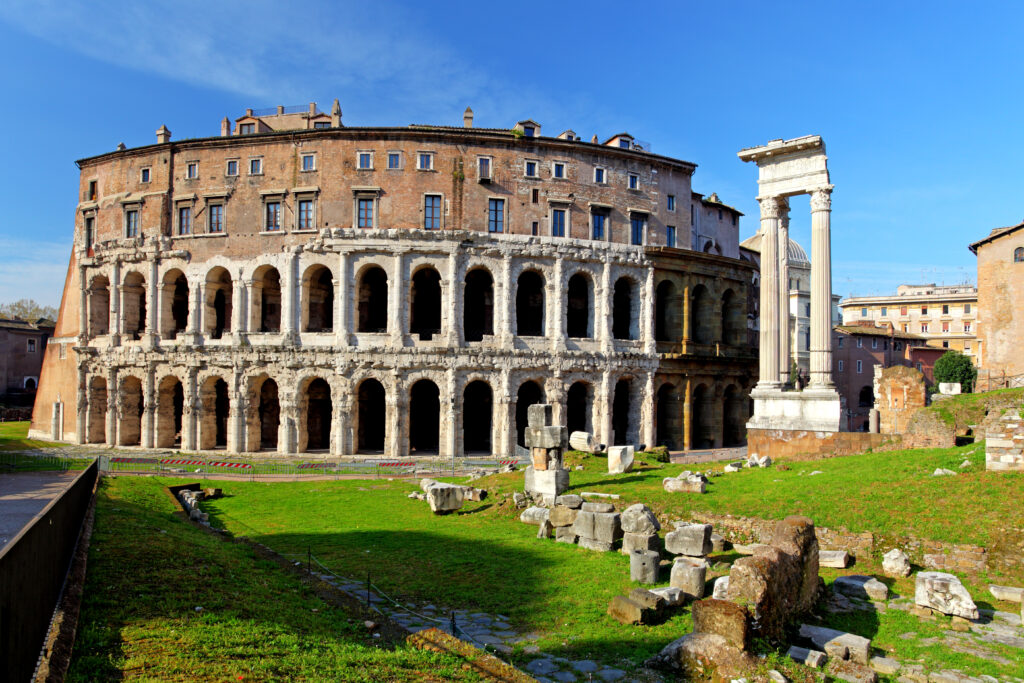
Credit: TTstudio / Adobe Stock
19. PIAZZA DEL POPOLO
You’ve probably heard the phrase that “all roads lead to Rome”–and specifically, they all led to Piazza del Popolo, which was once a traditional entrance point to the city.
Psst: In addition Pincio Terrace, located high above Piazza del Popolo, offers one of the best free views of Rome.
20. CARACALLA BATHS
Attend a summer concert under the stars
Ruins of a vast Roman bath complex hosts a varied line-up every year, where you can typically expect to find cinema, dance, jazz, opera, pop, and symphonic performances during the summer’s Caracalla Festival.
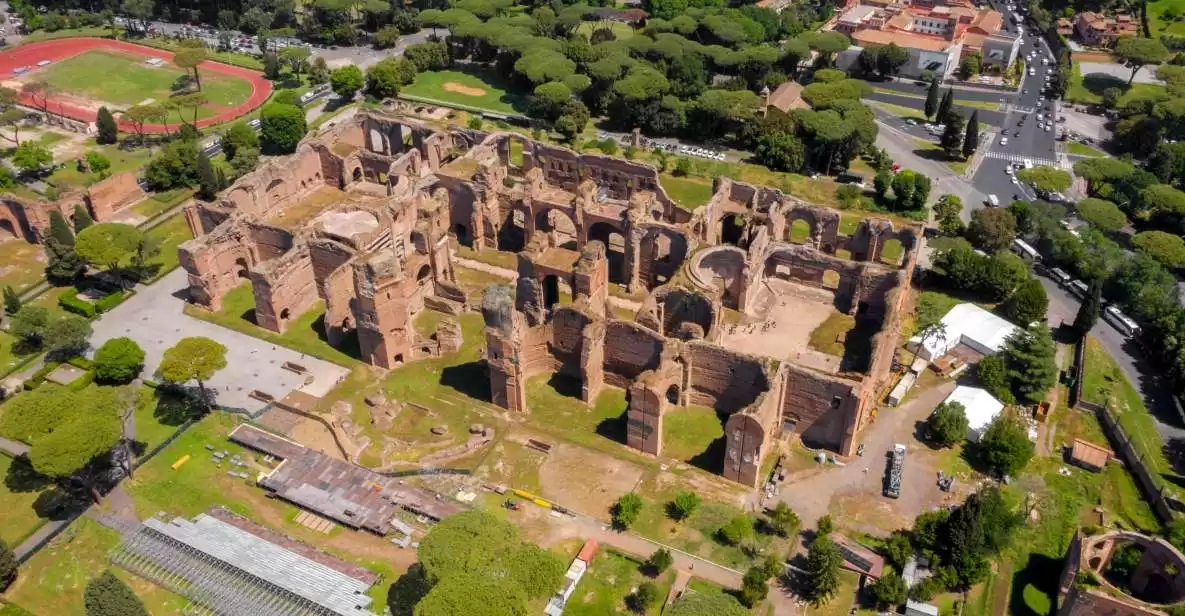 Baths of Caracalla - Outdoor Walking Tour with Entry Ticket
Baths of Caracalla - Outdoor Walking Tour with Entry Ticket
Skip the line entry.
Tour guide to show you the secrets behind the Baths of Caracalla
Duration is 2 hours
Free cancellation up to 24 hours before the activity.
21. PALAZZO COLONNA
Best way to spend Saturday morning
Palazzo Colonna is one of the oldest and largest private palaces in Rome. While the palace remains a private home for the Colonnas, it opens its doors to the public on Saturday mornings. Tickets include a guided tour at specific times.
22. L’ISOLA DEL CINEMA
Watch movies under the stars of rome
From mid-June to September a charming outdoor cinema pops up on the Isola Taberina – called L’Isola del Cinema – showing both international and Italian films.
23. GALLERIA DORIA PAMPHILJ
The Doria Pamphilj Gallery is a huge private art collection housed in the Palazzo Doria Pamphilj and is a true hidden gem in Rome.
The museum can be a bit crowded on Mondays when most museums in Rome are closed, but the place is rarely packed.
Good to know: You cannot take videos while inside the gallery!
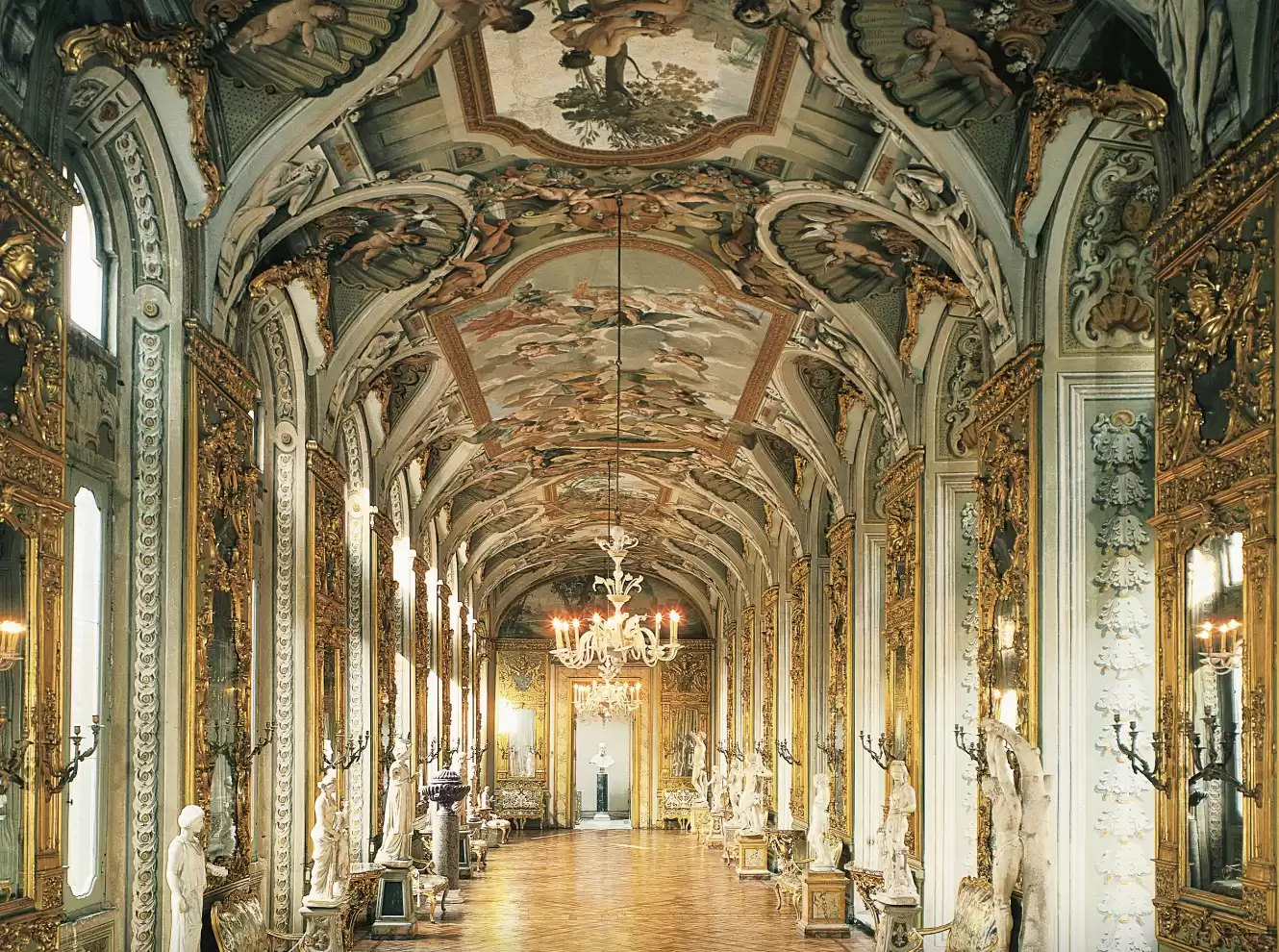 Reserved Entrance to Doria Pamphilj Gallery
Reserved Entrance to Doria Pamphilj Gallery
This place is unlike anything else. A mansion filled with art from some of Italy's most prominent artists like Raffaello and Caravaggio.
- Reserved Entrance
- Free cancellation up to 24 hours in advance
- 70 minutes duration
24. SANTA MARIA DELLA SCALA
Ancient pharmacy in the middle of Rome
Santa Maria Della Scala literally means: St Mary of the staircase, and is the oldest functioning pharmacy in Europe. When you enter the building on the ground floor, you step into a modern, active pharmacy, but can head upstairs to the ancient iteration. This is a true hidden gem off the usual tourist track!
Good to know: There’s a lot of stairs
25. VILLA FARNESINA
Art without the crowds
The Villa was the private residence of Agostino Chigi, one of the richest men who lived during the Renaissance, and is today a small museum covering two floors. The art on the walls and ceilings heavily weigh on depictions of gods and myths by Raphael. This is a place perfect for people who want to immersive themselves into art without the crowds.
Psst there’s detailed laminated pages describing the artwork in every room.
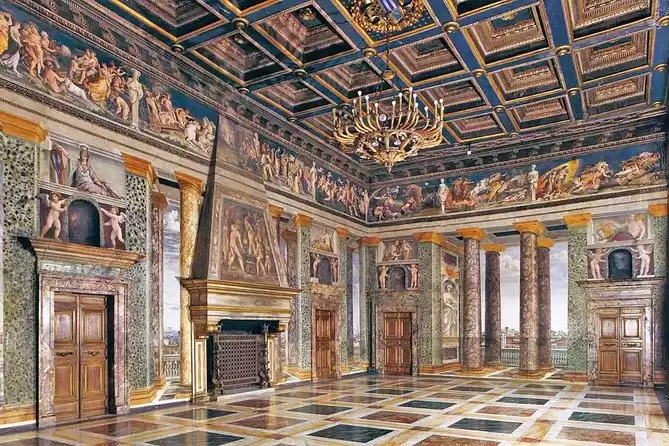 Villa Farnesina Private Tour
Villa Farnesina Private Tour
- Go back in time and discover true art up close
- Admire the masterpieces of the Renaissance home with a private guide
- Skip-the-line tickets
WHERE TO STAY IN ROME?
Rome is a massive city of almost 5 million people. With so many neighbourhoods and attractions, it’s essential to pick an area to have a base that suits your itinerary (and your budget), so you don’t spend all day transporting yourself back and forth.
Below are some of my recommendations for accommodation:
|
Description: Superior double room with ensuite bathroom 1.5 km from city centre |
Description: Double room with private bathroom 1.1 km from City centre |
Description: Double room with private bathroom 1.2 km from city centre |
Description: singe bed with Private bathroom 1.1km from city centre |
Description: 8 Bed Mixed Dorm Ensuite 2.1 km from city centre |
Description: 8 Bed Mixed Dorm 1.5 km from city centre |
|
Primary Rating:
4.0
|
Primary Rating:
4.4
|
Primary Rating:
2.9
|
Primary Rating:
3.2
|
Primary Rating:
3.9
|
Primary Rating:
3.0
|
|
€326/night
|
€221/night
|
€166/night
|
€132/night
|
€70/night
|
€53.5/night
|
Superior double room with ensuite bathroom
1.5 km from city centre
Double room with private bathroom
1.1 km from City centre
Double room with private bathroom
1.2 km from city centre
singe bed with Private bathroom
1.1km from city centre
8 Bed Mixed Dorm Ensuite
2.1 km from city centre
8 Bed Mixed Dorm
1.5 km from city centre
